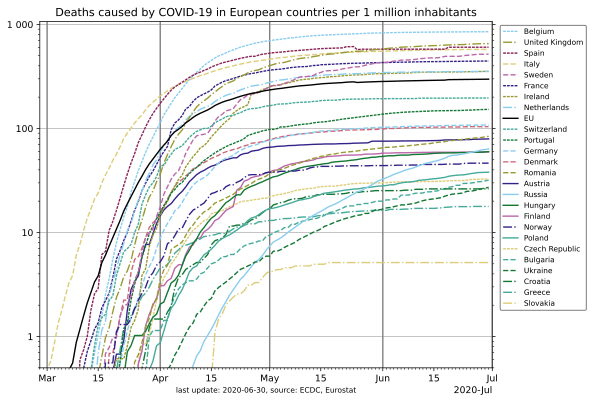COVID-19 pandemic in Europe
As of 13 March 2020, when the number of new cases became greater than those in China, the World Health Organization (WHO) began to consider Europe the active centre of the COVID-19 pandemic.[2][3] Cases by country across Europe had doubled over periods of typically 3 to 4 days, with some countries (mostly those at earlier stages of detection) showing doubling every 2 days.[4]
| COVID-19 pandemic in Europe | |
|---|---|
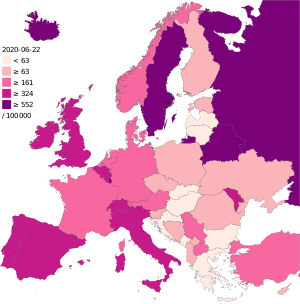 Confirmed cases of SARS-CoV-2 infected people in relation to the population of the country (cases per 100,000 inhabitants) | |
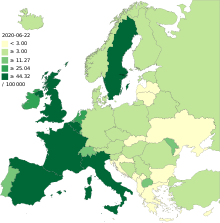 Cumulative number of deaths per 100,000 inhabitants from COVID-19 in Europe. | |
| Disease | COVID-19 |
| Virus strain | SARS-CoV-2 |
| Location | Europe |
| First outbreak | Wuhan, Hubei, China[1] |
| Index case | Bordeaux, France |
| Arrival date | 21 January 2020 (5 months, 1 week and 1 day ago) |
| Confirmed cases | 2,386,487 |
| Recovered | 1,326,640 |
Deaths | 190,041 |
Territories | 57 |
| Part of a series on the |
| COVID-19 pandemic |
|---|
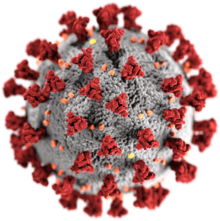 |
|
|
|
International response |
|
Medical response |
|
|
|
As of 17 March, all countries within Europe had a confirmed case of COVID-19, with Montenegro being the last European country to report at least one case.[5] At least one death has been reported in all European countries, apart from the Vatican City.
As of 18 March, more than 250 million people were in lockdown in Europe.[6]
As of 24 May, 68 days since its first recorded case, Montenegro became the first COVID-19-free country in Europe,[7][8] but this situation lasted only 44 days before a newly imported case was identified there.[9]
Statistics by country and territory
| Country/Territory | Cases | Deaths | Recoveries | Ref |
|---|---|---|---|---|
| 576,952 | 8,002 | 334,592 | [13] | |
| 303,110 | 42,589 | no data | [14] | |
| 244,683 | 27,136 | 150,376 | [15] | |
| 237,828 | 34,448 | 173,085 | [16] | |
| 187,764 | 8,856 | 171,900 | [17][18] | |
| 182,727 | 4,861 | 149,102 | [19][20] | |
| 159,452 | 29,617 | 72,572 | [21][22] | |
| 60,244 | 9,675 | 16,315 | [23] | |
| 56,032 | 324 | 27,760 | [24] | |
| 54,562 | 5,041 | no data | [25][26] | |
| 49,204 | 6,074 | no data | [27] | |
| 37,672 | 1,523 | 21,339 | [28] | |
| 34,063 | 966 | 13,976 | [29] | |
| 33,119 | 1,412 | 18,654 | [30] | |
| 31,100 | 1,677 | 28,800 | [31][32] | |
| 25,462 | 1,735 | 23,349 | [33][34] | |
| 22,760 | 1,451 | 15,283 | [35] | |
| 17,115 | 687 | 16,012 | [36] | |
| 12,732 | 433 | 5,738 | [37] | |
| 12,522 | 257 | 11,348 | [38] | |
| 12,294 | 598 | 10,755 | [39] | |
| 10,162 | 333 | 7,214 | [40] | |
| 8,660 | 243 | 8,138 | [41][42] | |
| 7,117 | 326 | 6,200 | [43] | |
| 4,820 | 222 | 1,863 | [44] | |
| 4,625 | 216 | 2,475 | [45] | |
| 4,085 | 110 | 3,918 | [46] | |
| 4,079 | 568 | 2,476 | [47] | |
| 3,227 | 187 | 1,442 | [48][49] | |
| 3,144 | 167 | 2,100 | [50] | |
| 2,696 | 108 | 2,152 | [51] | |
| 2,677 | 49 | 1,425 | [52] | |
| 2,330 | 53 | 1,346 | [53] | |
| 1,977 | 69 | 1,689 | [54][55] | |
| 1,815 | 10 | 1,794 | [56] | |
| 1,778 | 76 | 1,429 | [57] | |
| 1,561 | 28 | 1,409 | [58] | |
| 1,513 | 109 | 1,359 | [59] | |
| 1,104 | 30 | 794 | [60] | |
| 985 | 18 | 807 | [61] | |
| 853 | 51 | 781 | [62] | |
| 694 | 42 | 520 | [63] | |
| 670 | 9 | 639 | [64] | |
| 439 | 9 | 315 | [65] | |
| 336 | 24 | 309 | [66] | |
| 318 | 30 | 287 | [67] | |
| 252 | 13 | 238 | [68] | |
| 187 | 0 | 187 | [69] | |
| 161 | 0 | 148 | [70] | |
| 99 | 4 | 93 | [71] | |
| 82 | 1 | 55 | [72] | |
| 19 | 0 | 0 | ||
| 12 | 0 | 12 | [73] | |
| Total | 2,386,487 | 190,041 | 1,326,640 |
Pandemic by country and territory
Albania
Andorra
Austria
Belarus
Belgium
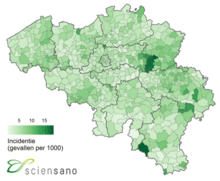
The COVID-19 pandemic in Belgium is part of the ongoing worldwide pandemic of coronavirus disease 2019 (COVID-19) caused by severe acute respiratory syndrome coronavirus 2 (SARS-CoV-2). The virus was confirmed to have spread to Belgium on 4 February 2020, when a Belgian national out of a group of nine Belgians repatriated from Wuhan to Brussels was reported to have tested positive for the coronavirus.[85][86] Transmission within Belgium was then confirmed early March, and was linked to holidaymakers returning from Northern Italy at the end of the half-term holidays.[87][88] The epidemic increased rapidly in March–April 2020. By the end of March, cases had been registered in all 10 provinces of the country.
As of 25 June 2020, there have been 61,007 confirmed cases reported by the Belgian authorities, with a total of 9,726 deaths and at least 17,688 discharged patients. Currently, 397 people in Belgian hospitals are suffering from COVID-19, including 84 in intensive care.[89] The actual number of infections, however, is likely to be much higher than the number of diagnosed cases, as laboratory tests are being limited to specific people and/or people with severe symptoms, and because many people with mild or no symptoms do not seek medical help, even as they are likely to be transmitting the virus.[90]
Belgium is the world's worst affected country in terms of the number of deaths per head of population (excluding Microstates). For example, on 1 June 2020, it was reported that there had been 819 deaths per one million head of population, compared to 442 in France, 580 in Spain, 592 in the United Kingdom[91], seven in Japan and three in China: Worldometer, 11pm, noted in The Times on 16 June. However, Prime Minister Sophie Wilmès contended that Belgium may be over-reporting the actual number of cases.[92] Unlike most other countries, which publish figures based primarily on confirmed hospital deaths, the deaths figures reported by the Belgian authorities include deaths in the community, especially in care homes, confirmed to have been caused by the coronavirus, as well as a much larger number of such deaths suspected to have been caused by the virus, even if the person was not tested.[93] Differences in methods of counting make inter-country comparisons of questionable accuracy.Bosnia and Herzegovina

The COVID-19 pandemic was confirmed to have reached Bosnia and Herzegovina on 5 March 2020 in a patient in Banja Luka, who had been in Italy during the COVID-19 pandemic. Later the same day, a second case was reported who was the son of the first case.[94] On 21 March 2020, the first death in the country from COVID-19 was announced in a hospital in Bihać. The patient was an elderly woman who had been hospitalized two days before.[95]
As of 26 June 2020, in Bosnia and Herzegovina there were 3,940 confirmed coronavirus cases, of which 2,090 were in Republika Srpska,[96][97] 1,824 in the Federation of Bosnia and Herzegovina,[98][99] and 26 in Brčko District.[100]
On 17 March 2020, the Council of Ministers of Bosnia and Herzegovina declared a state of emergency in all of Bosnia and Herzegovina.[101]Bulgaria
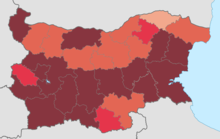
The COVID-19 pandemic was confirmed to have spread to Bulgaria when the country's first case was confirmed on 8 March 2020, a 27-year-old man from Pleven and a 75-year-old woman from Gabrovo. Neither of the two had traveled to areas with known coronavirus cases. The man tested positive for the virus after being hospitalized for a respiratory infection, and authorities announced plans to test several people who were in contact with the two individuals.[103] Two other samples in Pleven and Gabrovo were positive on 8 March.[104] Patient zero remains unknown.[105]
After the number of patients in the country had reached 23, the Bulgarian Parliament voted unanimously to declare a state of emergency from 13 March until 13 April.[106] A 14-day preventive house quarantine was introduced for citizens who have been in contact with a COVID-19 patient or have returned from an overseas region with a high number of cases. For patients tested positive for the virus a 21-day house quarantine was introduced. This time span is counted from the day a subsequent test comes out negative after they have been treated in a hospital or at home. After the World Health Organization (WHO) has established that COVID-19 is more resilient than the initial data was showing, the National Crisis-management Staff increased the recovery house quarantine by a week to 28 days.[107] With the continuing increase of COVID-19 cases on a daily basis, on 1 April the Bulgarian government requested that Parliament extends the state of emergency by one month until 13 May.[108]
As of 29 June 2020, there are 4,691 officially confirmed cases spread throughout all Bulgarian provinces, with 219 recorded deaths and 2,508 recoveries. A total of 133,605 PCR tests (or 19,227 per million citizens) had been performed by 29 June, with 3.51% being positive.[109]Croatia
On 25 February, Croatia confirmed its first case, a 26-year-old man who had been in Milan, Italy.[110] On 26 February, two new cases were confirmed, one being the twin brother of the first.[111] In March 2020, a cluster of cases were reported in numerous Croatian cities. On 12 March, the first recovery was reported, and on 18 March the first death from the virus was confirmed. On 19 March, the number of recorded cases surpassed 100. On 21 March, it surpassed 200. On 25 March, it surpassed 400. On 31 March, it surpassed 800. The pandemic in Croatia occurred during the Croatian Presidency of the Council of the European Union.[112]
On 22 March, an intense earthquake hit Zagreb, the capital of Croatia, causing problems in enforcement of social distancing measures set out by the Government. The earthquake could also be felt across much of Croatia, Bosnia and Herzegovina, Hungary, Slovenia, and Austria.[113][114]
According to Oxford University, as of 24 March, Croatia is the country with the world's strictest restrictions and measures for infection reduction in relation to the number of infected.[115] The government set up a website for all information about the virus and a new phone line 113 that has volunteers answering questions.[116]
Cyprus
On 9 March, Cyprus confirmed its first two cases, one in Nicosia and one in Limassol.[117][118][119]
Czech Republic
.jpg)
The first case was reported in the country on 1 March.[40] As of 22 March there had been 1120 confirmed cases, with one lethal outcome.[40]
On 12 March, the Czech Republic declared a 30-day state of emergency and barred entry to non-residents from China, South Korea, Iran, Italy, Spain, Austria, Germany, Switzerland, Sweden, UK, Norway, Denmark and France.[120]
The Czech Republic banned people from going out in public without wearing a face mask or covering their nose and mouth.[121]
Denmark
On 27 February, Denmark confirmed its first case.[122]
As of 16 March, there have been 898 confirmed cases in Denmark, including 11 in the Faroe Islands (see below).[123]
Numerous preventive measures gradually were implemented. Starting on 13 March, schools, universities and similar places were closed, while most people in non-essential functions have been sent home to work.[124] On 14 March, the borders were closed for all entries, except Danish citizens, people with a residence permit, people with an important reason for visiting, and transport of goods.[125][120]
Estonia
On 27 February Estonia confirmed its first case, an Iranian citizen, travelling from Iran via Turkey.[126]
As of 11 March there were 17 confirmed cases in Estonia. 12 of them had returned with the infection from Northern Italy, one from France, one from Iran and one from undisclosed risk area.[127][128] First two cases of virus transmitting locally were in Saaremaa after international volleyball competition involving a team from Milan.[129]
From 12 March the virus was spreading locally. The number of infected grew fast reaching 109 on 14 March.[130]
France

On 24 January, the first case in Europe was confirmed in Bordeaux. Two more cases were confirmed in Paris by the end of the day, all of them originated from China. A cluster of infections was discovered in Haute-Savoie which originated from a British national who had visited Singapore.[133][134][135]
From 31 January to 9 February, nearly 550 people were repatriated from Wuhan on a series of evacuation flights arriving at Creil Air Base in Oise and Istres-Le Tubé Air Base in Istres.[136]
On 14 February, an 80-year-old Chinese tourist died in Bichat–Claude Bernard Hospital, Paris, marking the first death from COVID-19 in Europe and France.[137]
According to regional council president Jean Rottner, the starting point for the first intense wave in Alsace was the Fasting Meeting of the Protestant Free Church of La Porte Ouverte in Mulhouse, with more than 2500 visitors, in mid-February.[138] On 12 March, French president Emmanuel Macron announced on public television that all schools and all universities would close from Monday 16 March until further notice. The next day, the prime minister Édouard Philippe banned gatherings of more than 100 people, not including public transportation. The following day, the prime minister ordered the closure of all nonessential public places, including restaurants, cafés, cinemas, and discothèques, effective at midnight.[139]
As of 14 March, there had been 4,499 confirmed cases (a near-four-fold increase over the number 5 days previously), and 91 deaths in France.[140]
As of 20 March, the number of confirmed cases had risen to 12,612, while the number of deaths reached 450. As of March 30, more than six hundred doctors and other medical workers are suing the former Minister of Health and the Prime Minister for "culpable negligence" in failing to prepare for the epidemic.[141]
Until 1 April, the daily update of the number of deaths in France included only deaths in hospitals, with deaths in retirement homes or at home not included in the update.[142] Deaths in retirement homes were included in the reported figures from 2 April, causing totals to increase substantially.[143]
On 4 May, retroactive testing of samples in one French hospital showed a patient "who had COVID-19 as early as Dec. 27, nearly a month before the French government confirmed its first cases."[144] According to the researchers who reported the discovery, this indicates that the virus was present in the population well before the first confirmed cases, a finding also echoed by US researchers.[145]
Germany
In Germany, the first case of COVID-19 was recorded in the state of Bavaria on January 27, 2020. Daily case numbers began to decrease after April 8. As of 19 April 2020, 145,742 cases have been reported with 4,642 deaths and approximately 81,800 recoveries.[146][147][148][149] That makes Germany the world's 4th and Europe's 3rd worst-hit country in terms of total cases. The coronavirus mortality rate is, however, reported comparatively lesser at 1.3%, ranking 8th in the world and 5th in Europe in the total number of deaths.[150] The low preliminary fatality rate in Germany, compared to Italy and Spain, has resulted in a discussion and explanations that cite among others the country's higher number of tests performed, absence of COVID-19 analyses in autopsies and higher proportion of positive cases among younger people. Hessian state finance minister Thomas Schäfer committed suicide on 28 March 2020. News reports about the causes for his decision to end his life cited stress and worries over the state of the country's economic situation due to COVID-19,[151] and handling the developing pandemic.[152]
Greece
On 26 February, the first case in Greece was confirmed, a 38-year-old woman from Thessaloniki who had recently visited Northern Italy.[153] The next day, the first patient's 9-year-old child and another 40-year-old woman, who had travelled to Italy, also tested positive.[154][155][156] Subsequent cases is Greece were mainly related to people who had travelled to Italy and a group of pilgrims who had travelled to Israel and Egypt, as well as their contacts.[157][158] Health and state authorities issued precautionary guidelines and recommendations, while measures up to that point were taken locally and included the closure of schools and the suspension of cultural events in the affected areas (particularly Ilia, Achaea and Zakynthos).[158] The first confirmed death from COVID-19 in Greece was a 66-year-old man, who died on 12 March.[159]
By 17 June, there were 3203 confirmed cases in Greece, 187 deaths and 1442 recoveries.[48][49] The Greek National Public Health Organization (NPHO), in collaboration with local authorities and doctors, is tracking and testing everyone who came in close contact with the patients.[160][161] By March 10, with 89 confirmed cases and no deaths in the country, the government decided to suspend the operation of educational institutions of all levels nationwide and then, on 13 March, to close down all cafes, bars, museums, shopping centres, sports facilities and restaurants in the country.[162][163] On 16 March, all retail shops were also closed and all services in all areas of religious worship of any religion or dogma were suspended.[164][165] On 18 and 19 March, the government announced a series of measures of more than 10 billion euros to support the economy, businesses and employees.[166]
On 22 March the Greek authorities announced significant restrictions on all nonessential transport and movement across the country, starting from 6 a.m. on 23 March.[167] Starting from 4 May, Greece has begun easing its lockdown restrictions after a 42-day lockdown, with the gradual lifting of movement restrictions and restart of business activity.[168]
Guernsey
On 9 March, the first case in the crown dependency was confirmed.[169]
Hungary
On 4 March Prime Minister Viktor Orbán announced that two Iranian students had been infected with the virus.[170] The students are asymptomatic and have been transported to Saint Ladislaus Hospital in Budapest.[170]
Iceland
The first case was confirmed in Iceland on 28 February, an Icelandic male in his forties who had been on a ski trip to Andalo in Northern Italy and returned home on 22 February.[171]
Iceland's Department of Civil Protection and Emergency Management declared a state of emergency on 6 March after two cases of community transmission in Iceland were confirmed, bringing the total number of confirmed cases to 43.[172] On 13 March, it was announced at an official press conference that a four-week ban on public gatherings of more than 100 persons would be put into effect as of Monday 16 March. Universities and secondary schools will be closed for four weeks. International airports and harbours will remain exempt from these measures.[173]
Ireland
The National Public Health Emergency Team of Ireland announced the first case in Ireland on 29 February.[174][175] Response to the outbreak has included cancellation of St Patrick's Day parades and all festivals.[176] On 12 March, Taoiseach Leo Varadkar announced the closure of all schools, universities and childcare institutes.[177] On 20 March, an emergency legislation was signed into law by President Michael D. Higgins giving the state permission to detain people, restrict travel and keep people in their homes to help combat the spread of the pandemic.[178]
Starting from 5 May there has been staged easing of restrictions.[179]
As of 29 June, the Department of Health have confirmed 25,462 confirmed cases and 1,735 deaths.[180]
Italy
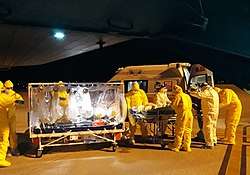
On 31 January, the first two cases were confirmed in Rome. Two Chinese tourists, who arrived in Milan on 23 January via Milan Malpensa Airport and travelled to Rome on a tourist bus, tested positive for and were hospitalised in Lazzaro Spallanzani National Institute for Infectious Diseases.[181]
On 6 February, one of the Italians repatriated from Wuhan, China, tested positive, bringing the total number of cases in Italy to three.[182] On 22 February, the repatriated Italian recovered and was discharged from the hospital.[183] On 22 and 26 February, the two Chinese tourists hospitalized in Rome tested negative.[184]
On 21 February, a cluster of cases was detected starting with 16 confirmed cases in Lombardy,[185] with additional 60 cases on 22 February,[186] and Italy's first deaths reported on the same day.[187] As of late February, Italy was hit harder than anywhere else in the EU by the COVID-19 outbreak.[188]
As of 17 March 2020, there have been 2,503 deaths and 31,506 confirmed cases.[189] By 15 May 2020, there had been 223,885 cases and 31,610 deaths, according to Protezione Civile bulletins.
Lockdown
On 8 March, Italian prime minister Giuseppe Conte signed a decree enacting a quarantine for the entire region of Lombardy – home to more than 10 million people and the financial capital, Milan – and multiple other provinces, totalling around 16 million residents. The lockdown decree included the power to impose fines on anyone caught entering or leaving Lombardy, the worst-affected region, until 3 April.[190]
On 9 March, the lockdown orders were extended to the whole of Italy, effectively quarantining more than 60 million people.[191]
Kosovo
The first two cases in Kosovo[lower-alpha 1] were reported on 13 March. In the ten-day period March 13–23, the number of positive cases with coronavirus rose to 35. In midnight of 23 March, 26 new cases were confirmed, bringing the total number of cases to 61.[192] On March 25, the government collapsed with a vote of no confidence in Prime Minister Albin Kurti.[193]
Latvia

The COVID-19 pandemic was confirmed to have reached Latvia on 2 March 2020.[194][195]
On 13 March, the government closed all educational institutions and banned mass gatherings until 14 April, which was later extended to 12 May. Many concerts and events were cancelled and moved to other dates. As of 20 March at least 1,600 culture and entertainment events had been disrupted.[196]Liechtenstein
The first case was reported in the country on 3 March.[197]
Lithuania
The first case was reported in the country on 28 February. By March 17 there were 21 cases, mostly in Vilnius, Kaunas and Klaipėda. The first infected Lithuanian recovered on 14 March.[198]
Luxembourg
The first case was reported in the country on 29 February.
Malta
On 7 March, Malta reported its first 3 cases of coronavirus: an Italian family consisting of a 12-year-old girl and her parents, who arrived in Malta on 3 March from Rome after a holiday in Trentino.[199]
Moldova

(20 June 2020)
Montenegro
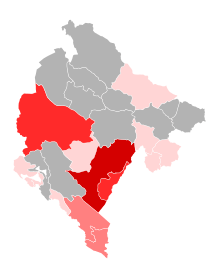
The COVID-19 pandemic was confirmed to have spread to Montenegro when its first case was confirmed on 17 March 2020,[203][204] making it the last European country to register a case of SARS-CoV-2.[205]
As of 18 June 2020, the total number of cases in Montenegro is 337.[206]
On 24 May 2020, 68 days after the first case was recorded in Montenegro, it became the first corona-free country in Europe.[207][208] Within the first outbreak, indexed cases counted 9% of the total reported, 80% of cases were infected due to contact with primary cases, while the origin of infection of the other 11% of cases was not certain.[209] The Government of Montenegro estimated that the country needs EUR 59.2 million private and international relief to address the health, social and economical impact of COVID-19.[210]
Montenegro had 0 active cases from 24 May until 14 June when the first imported case was reported.Netherlands
On 27 February, the Netherlands confirmed its first case, a man who had been in the Lombardy region of Italy.[211]
On 6 March, RIVM announced the first death.[212]
On 9 March, RIVM announced 56 more confirmed cases in addition to the total of the 77 infected patients declared in the previous day, bringing the total to 321 infected and 3 dead.[213]
On 15 March, the Dutch government announced in a press conference that all schools, day care facilities, colleges, universities, and universities of applied sciences would close until 6 April, though children of parents in vital industries could still go to school or the day care if they could not be taken care of otherwise.[214]
As of 16 March, the total number of confirmed cases of COVID-19 had risen to 1,413 and the total number of confirmed deaths had risen to 24. This was an increase of 278 infections and 4 deaths in comparison to 15 March.[215]
On the same date, the Minister President of the Netherlands, Mark Rutte, had announced that the country would not go into complete lockdown. Instead the situation would be controlled as much as possible by delaying the spread of the virus, relying on measures taken earlier by the government, such as social distancing and prohibiting gatherings of 100 people and over.[216] It is expected the coronavirus will keep spreading and a large part of the population will become infected. Instead of opting to lock down the Netherlands for the time required, which would have many (negative) consequences while the benefits remain uncertain and would have to stay in place, it will be attempted to build herd immunity in a controlled manner. Depending on how the virus behaves, the government will decide if additional measures are required.[216][217]
Further measures were introduced on 23 March. All events will be banned until 1 September. Gatherings of more than three people, except for families, are prohibited. City mayors received greater authorization to enforce the rules. Fines will be issued to those not complying with the new rules.[218]
North Macedonia
On 26 February, North Macedonia confirmed its first case, a woman that had returned from Italy.[219] On 10 March every school, kindergarten and university was closed. As of 20 June, the country has reported 4820 cases, 222 deaths and a total of 1863 recovered. [220]
To stop the spreading of the virus, the country had a strict 61 hour curfew every weekend. For holidays, as Easter the country had a 85-hour curfew. [221] [222] Furthermore, the state of emergency which had expired was extended for 14 more days until the 30th May, and then again for 14 more days until the 13th June.[223]
Norway

On 26 February, Norway confirmed its first case, in a person who had returned from China the previous week.[224][225]
On 7 March, there were 147 confirmed cases in Norway. Most of the cases could either be linked to outbreaks abroad or close encounters with these. Altogether 89 have been infected on travel in Italy.[226]
On 12 March 2020, all kindergartens, schools, colleges and universities were closed until at least 26 March 2020.[227]
Poland
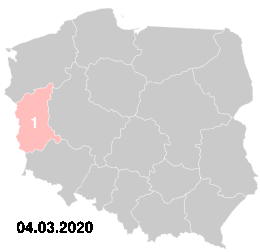
The COVID-19 pandemic in Poland is part of the worldwide pandemic of coronavirus disease 2019 (COVID-19) caused by severe acute respiratory syndrome coronavirus 2 (SARS-CoV-2). In February and March 2020, health authorities in Poland carried out laboratory testing of suspected cases of infection by SARS-CoV-2, one of the seven known human coronaviruses, as well as home quarantining and monitoring.[228][229] The first case of a laboratory confirmed SARS-CoV-2 infection in Poland was that of a man hospitalised in Zielona Góra, with confirmation announced officially on 4 March 2020.[230][231] The local transmission phase of SARS-CoV-2 in Poland was declared to the World Health Organization on 10 March.[232][233] The first death from coronavirus disease 2019 (COVID-19) in Poland was that of a 56-year-old woman on 12 March.[234] Polish authorities did not participate in the 28 February 2020 European Union tender procedure for purchasing COVID-19 pandemic related medical equipment, in which 20 other member states participated. Poland applied on 6 March for the 17 March tender for the purchase of gloves, goggles, face shields, surgical masks and protective clothing; the European Commission stated that all requests in the tender were satisfied by offers.[235]
As of 25 June 2020, there were 33,119 laboratory confirmed SARS-CoV-2 cases,[236] 1,412 deaths,[237] and 18,654 recoveries.[238]
Lockdown-type control measures started on 10–12 March, closing schools and university classes and cancelling mass events,[239][240][241] and were strengthened on 25 March, limiting non-family gatherings to two people and religious gatherings to six and forbidding non-essential travel.[242] On 20 March, the Ministry of Health tried to prevent medical personnel from commenting on the pandemic. The Polish Ombudsman Adam Bodnar defended medical personnel's right to speak publicly about the epidemic on constitutional grounds of freedom of speech and the right of the public to information. Doctors opposed the self-censorship orders.[243] Fatality counts initially only included deaths from lab-confirmed SARS-CoV-2 infection (U07.1[244]).[245] Starting on 1 April 2020, fatalities that were clinically or epidemiologically diagnosed as COVID-19 (U07.2)[244]) were also considered as COVID-19 deaths by NIPH–NIH.[246] As of 28 March 2020, people in Poland who died in quarantine from suspected COVID-19 were not tested post mortem for SARS-CoV-2.[247] As of 29 March 2020, there were 269,307 people under quarantine for suspected SARS-CoV-2 infection and 42,783 SARS-CoV-2 tests had been made since the beginning of testing.[248] The lockdown restrictions were tightened starting on 31 March–1 April by a government regulation, requiring individuals walking in streets to be separated by two metres, closing parks, boulevards, beaches, hairdressers and beauty salons, and forbidding unaccompanied minors from exiting their homes.[249] A followup regulation on 10 April loosened the restrictions on public gatherings starting from 20 April, allowing religious gatherings and funerals to be held for up to a maximum of 50 people.[250]Portugal
On 2 March, the first two cases were confirmed in Portugal, both in the city of Porto. One was a doctor that had returned from holiday in northern Italy and the other a worker from Spain.[251][252]
On 18 March, the President of the Republic, Marcelo Rebelo de Sousa, declared the entirety of the Portuguese territory in a state of emergency for the following fifteen days, with the possibility of renewal, the first since the Carnation Revolution in 1974.[253]
On 24 March the Portuguese Government admitted that the country could not contain anymore the COVID-19 as it is wide spreading and will enter the 'Mitigation Phase' on 26 March.[254]
Romania
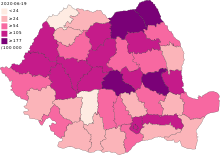
The COVID-19 pandemic in Romania is part of the ongoing pandemic of coronavirus disease 2019 (COVID-19) caused by severe acute respiratory syndrome coronavirus 2 (SARS-CoV-2). The virus was confirmed to have reached Romania on 26 February 2020, when the first case in Gorj County was confirmed.[255]
As of 27 June, the Romanian Government reports 1,061 people in institutional quarantine, a further 69,472 in home isolation under medical supervision, and 687,618[256] tests having been processed.[257]Russia
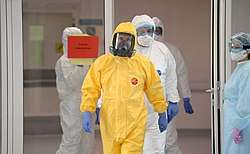
Russia implemented preventive measures to curb the spread of COVID-19 in the country by imposing quarantines, carrying raids on potential virus carriers and using facial recognition to impose quarantine measures.[258]
On 2 March, Western Russia confirmed its first case in Moscow Oblast.[259][260] Previously on 31 January Russia confirmed first two cases in its Asian part, one in Tyumen Oblast and another in Zabaykalsky Krai. Both were Chinese nationals, who have since recovered.[261][258]
On 7 March, four new cases were confirmed, three was in Lipetsk and one in Saint Petersburg. All people visited Italy in the previous two weeks.[262]
On 8 March, three news cases were confirmed, in Moscow, Belgorod and Kaliningrad Oblasts. All people returned from Italy.[263]
On 10 March, Moscow Mayor Sergey Sobyanin signed a decree for banning mass events in Moscow with more than 5000 participants from 10 March to 10 April.[264]
By 15 April, cases were confirmed in all of Western Russia's federal subjects with the confirmation of the first case in Nenets Autonomous Okrug.
San Marino
On 27 February, San Marino confirmed its first case, an 88-year-old man with pre-existing medical conditions, who came from Italy. He was hospitalised at a hospital in Rimini, Italy.[265] As of 25 March 2020: With 700 confirmed cases out of a population of 33,344 (as of 2018), it is the country with the highest percentage of confirmed cases per capita at 2.1% – 1 confirmed case per 48 inhabitants.[266] Also, with 42 confirmed deaths, the country has the highest rate of confirmed deaths per capita at 0.126% of the total population – 1 death per 794 inhabitants.[266]
Serbia
On 29 February, a massive infection occurred in the town of Valjevo after a private party involving a guest from Austria who had previously stayed in Italy.[267][268] On 6 March, the first case was confirmed in Serbia by Minister of Health Zlatibor Lončar,[269] of a man who had traveled to Budapest.[270] President Aleksandar Vucic and the Government of the Republic of Serbia introduced a state of emergency on March 15. Two days later, curfew and quarantine were introduced as safeguards against massive infection.
Slovakia

.jpg)
On 6 March Slovakia confirmed its first case, a 52-year-old man coming from a small village nearby Bratislava. He had not travelled anywhere in recent weeks but his son had visited Venice.[271] His son didn't show any symptoms. On 7 March, the virus was also confirmed in his wife and son.[272]
Slovenia
On 4 March Slovenia confirmed its first case. A patient of about 60 years of age had returned from Morocco few days earlier (via Italy) and was admitted to a hospital in Ljubljana.[273][274]
On 6 March, a total of eight cases were reported, three of them medical professionals, who contracted the virus on holiday in Italy. By 9 March, 16 people were confirmed to be infected.
Spain

On 31 January, Spain confirmed its first case, in the Canary Island of La Gomera. A tourist from Germany tested positive and was admitted to University Hospital of the Nuestra Señora de Candelaria.[275][276][277] On 19 February, 2,500 soccer fans from Valencia attended a Champions League game in Bergamo, the hot spot of the outbreak in Italy.[278]
On 24 February, a medical doctor from Lombardy, Italy who was vacationing in Tenerife, tested positive at the University Hospital of the Nuestra Señora de Candelaria in Spain.[279][280] Afterwards, multiple cases were detected in Tenerife involving people who had come in contact with the doctor. Other cases involving individuals who visited Italy were also discovered on Spanish mainland.[281]
On Saturday 14 March, the Spanish government imposed a nationwide quarantine, banned all trips that are not necessary and announced that companies may be intervened to guarantee supplies.[282][283] However, with universities and schools closed earlier that week, bars and parks were full, and due to slow enactment "part of the population of Madrid and other cities had dispersed across the country".[278] As of 17 March 2020, there had been 11,826 confirmed cases with 1,028 recoveries and 533 deaths in Spain.[284]
On 28 March, the Spanish government tightened up its national lockdown, ordering all non-essential workers to stay at home for the next two weeks.[285] Nearly 900,000 workers lost their jobs in Spain since it went into lockdown in mid-March 2020.[286]
Sweden
On 31 January, Sweden confirmed its first case. A woman in her 20s, who had visited Wuhan, tested positive and was admitted at Ryhov County Hospital in Jönköping.[287][288]
On 26 February, following the outbreak in Italy and in Iran, infection clusters originating from these two countries appeared in Sweden.[289] A number of individuals in Västra Götaland, Jönköping, Stockholm and Uppsala tested positive and were admitted to the infectious disease units in the respective counties.[290]
The country's first fatality came on 11 March, that of a man in Stockholm over 60 who had other illnesses prior to infection.
As of 12 March, national testing strategy shifted to only the elderly, the severely ill, and healthcare personnel. The official recommendation for symptoms that were not serious, as of 13 March, was to stay at home and not visit healthcare. This has led to statistics becoming less useful.[291]
As of 14 March, 924 people were reported as having become infected. The Ministry for Foreign Affairs of Sweden made the recommendation to refrain from unnecessary travel to all countries.
Switzerland
On 25 February, following the outbreak in Italy, Switzerland confirmed its first case, a 70-year-old man in the Italian-speaking canton of Ticino, who had previously visited Milan.[292][293] Afterwards, multiple cases related to the Italy clusters were discovered in multiple cantons including Basel-City, Zürich and Graubünden.[294][295][296] Multiple isolated cases not related to the Italian clusters were also confirmed.[297]
On 28 February, the Federal Council announced an immediate ban on all events with more than 1,000 participants.[298]
As of 10 March, there were 500 confirmed cases in Switzerland.[299] On 16 March 2020, the Federal Council announced[300] further measures, and a revised ordinance.[301] Measures include the closure of bars, shops and other gathering places until 19 April, but leaves open certain essentials, such as grocery stores, pharmacies, (a reduced) public transport and the postal service.[302] Those measures were prolonged until 26 April 2020.[303]
Turkey
The COVID-19 pandemic in Turkey is part of the ongoing pandemic of coronavirus disease 2019 (COVID-19) caused by severe acute respiratory syndrome coronavirus 2 (SARS-CoV-2). The disease was confirmed to have reached Turkey on 11 March 2020, after a man who had returned to Turkey from Europe, tested positive.[304] The first death due to COVID-19 in the country occurred on 15 March 2020 and by 1 April, it was confirmed that COVID-19 had spread all over Turkey.[305] On 14 April 2020, the head of the Turkish Ministry of Health Fahrettin Koca announced that the spread of the virus in Turkey has reached its peak in the fourth week and started to slow down.[306]
As of 28 June 2020, the total number of confirmed cases in the country is over 197,200 of which 170,500 have recovered and 5,000 have died.[307] On 18 April 2020, the total number of positive test results surpassed that of Iran, making it the highest in the Middle East.[308][309] Turkey also surpassed China in confirmed total cases on 20 April 2020.[310] The rapid increase of the confirmed cases in Turkey did not overburden the public healthcare system[311], and the preliminary case-fatality rate remained lower compared to many European countries.[312][313] Discussions mainly attributed these to the country's relatively young population and high number of available intensive care units.[314][315]Ukraine
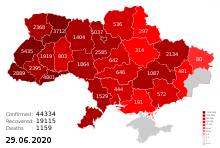
The COVID-19 pandemic in Ukraine is part of the worldwide pandemic of coronavirus disease 2019 (COVID-19) caused by severe acute respiratory syndrome coronavirus 2 (SARS-CoV-2). The virus was confirmed to have spread to Ukraine when the country's first case was confirmed to be hospitalized in Chernivtsi Oblast on 3 March 2020,[316] a man who had travelled from Italy to Romania by plane and then arrived in Ukraine by car.[317]
An emergency was declared on 20 March in the Kiev Oblast, Chernivtsi Oblast, Zhytomyr Oblast, Dnipropetrovsk Oblast, Ivano-Frankivsk Oblast and in the city of Kiev.[318]
Statistics for the Russian-held Autonomous Republic of Crimea and city of Sevastopol, and for the unrecognized Donetsk People's Republic and Luhansk People's Republic in eastern Ukraine are not reported by Ukraine's state agencies, and not included in the country's totals.[319] See separate articles about the pandemic in Crimea, the pandemic in Sevastopol, the pandemic in the DNR, and the pandemic in the LNR.United Kingdom
.jpg)
On 31 January, England confirmed the first two cases, both members of a family of Chinese nationals staying in a hotel in York who were taken to specialist facilities in Newcastle upon Tyne.[320] Afterwards, several confirmed cases were detected across the UK.[321][322][323] The UK government implemented preventive measures to curb the spread of infections which included contact tracing, isolation and testing, some of which were related to the Italy clusters.[324][325][326] The NHS set up drive-through screening centres at several hospitals to test members of the public showing symptoms.[327][328] This effort was later replaced with screening focused on diagnosing patients in secondary care.
On 2 March, Ministers approved the Department of Health and Social Care coronavirus action plan,[329] which sets out actions to date, future measures, cooperation between devolved political and health authorities, and the level of preparedness of the country's four National Health Services. It outlined the government's objectives to deploy phased actions to Contain, Delay, and Mitigate any outbreak, using Research to inform policy development.[330]
On 25 March, the UK Parliament legislated to provide the government and authorities with emergency powers to handle the 2020 coronavirus pandemic, such as the power to restrict public gatherings, order businesses to close, and the ability to detain those suspected of having the virus.[331] The Coronavirus Act 2020 received Royal Assent on 25 March and came into force on the same day.[332]
On 5 April, the Prime Minister of the United Kingdom Boris Johnson was admitted to hospital after testing positive to coronavirus 10 days earlier.[333] He was admitted into intensive care the following night, when his symptoms further worsened.[334] He left hospital on 12 April.[335]
As of 6 May, the total of confirmed cases was 201,101; the total of recorded deaths in all settings was 30,076, the highest in Europe and second highest in all the countries after United States.[336]
Vatican City

The Holy See reported the first case of infection in Vatican City during the COVID-19 pandemic at the end of March 2020.[337] Unlike other jurisdictions that report cases within a given territory or cases of residents or citizens of a territory, the Holy See reports on cases "in Vatican City State and among the employees of the Holy See" regardless of location of testing, treatment, or residence.[338] There were 12 confirmed cases of COVID-19 among the Vatican's residents and employees; there were no associated deaths.[339] The 12 cases included 10 employees, 1 new hire, and 1 resident of Vatican City.[lower-alpha 2] All those infected tested negative by 6 June 2020.[340]
In late February, Pope Francis became ill with symptoms of a cold, but he tested negative for COVID-19.[341]Pandemic development graphs
Confirmed cases and deaths by date
Confirmed cases by date
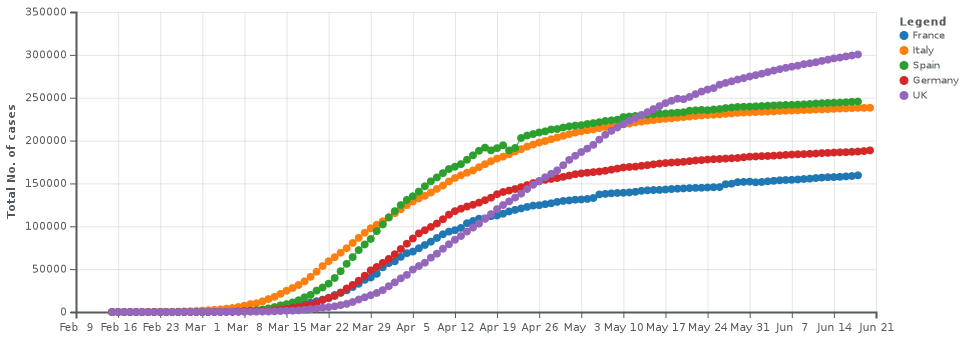
Deaths by date
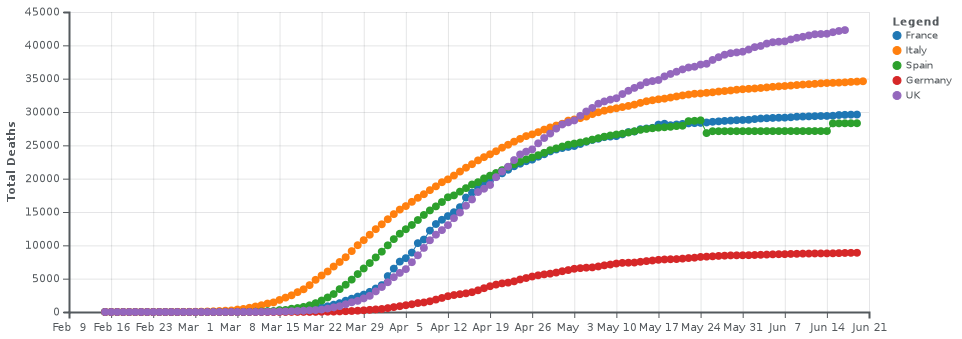
Total confirmed cases since first day of the outbreak

Growth rates comparison since outbreak
Syncing the start date to the 10th case, comparing the daily growth in cases
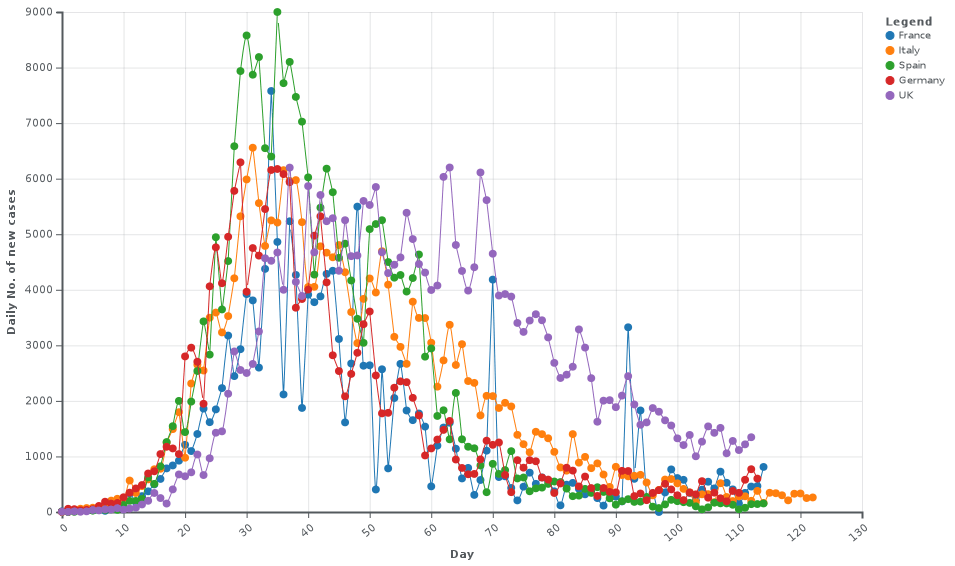
Syncing the start date to the 10th case, comparing the daily deaths
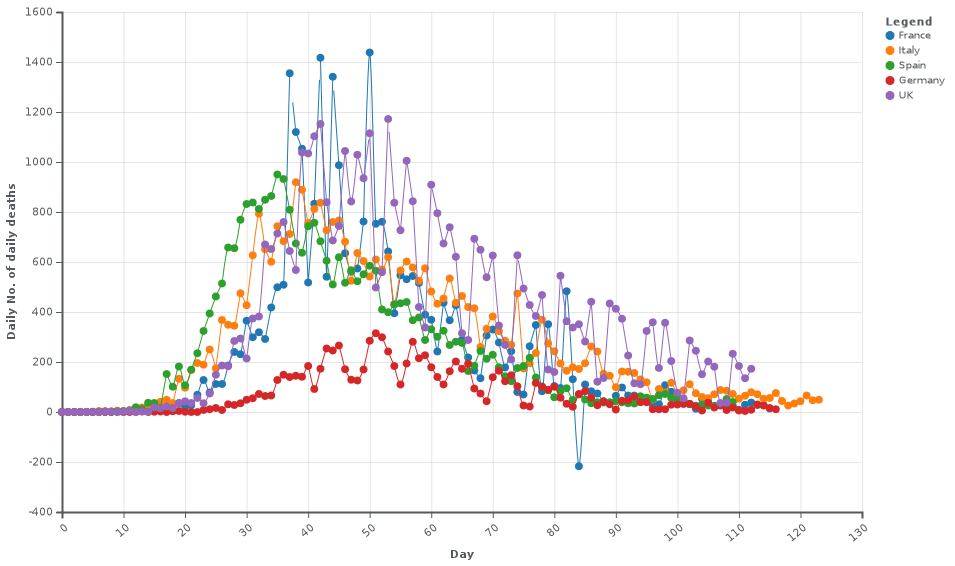
Daily new cases; syncing the start date to the 100th case:

Daily new cases; syncing the start date to the 500th case:

Response and criticism
Timeline of interventions
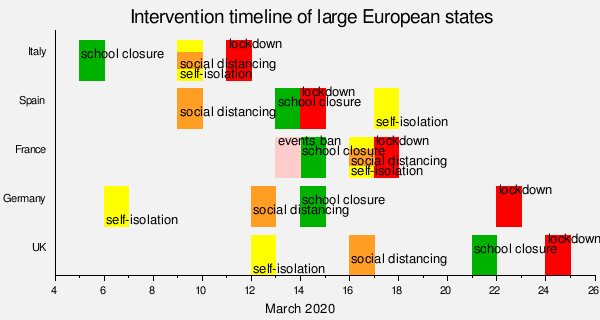
Immigrants and refugees
European Union closed borders to non-nationals on 17 March. The next day, Greece imposed restrictions on refugees’ movement within camps.[342] Thousands of asylum seekers are living in crowded camps, and there are fears that pandemic could not be controlled under such conditions. The Greek prime minister K. Mitsotakis said that Europe should do more to help because Greece "cannot resolve this crisis instantly and alone".[343] Unnamed Greek officials have stated concerns that Turkey may send infected refugees and migrants towards the islands.[344][345][346] Early in April Malta and Italy closed their ports to vessels carrying asylum seekers from North Africa.[347]
Criticism
Although by 7 March some European politicians such as France's Marine Le Pen had called for Europe's internal borders to be temporarily closed,[348] the European Union by 13 March continued to reject the idea of suspending the Schengen free travel area and introducing border controls with Italy.[349][350][351][352] The deputy leader of the Swiss Ticino League, Lorenzo Quadri, by 29 February had criticised the decision: "It is alarming that the dogma of wide-open borders is considered a priority."[353] United States President Donald Trump said by 12 March the European Union had "failed to take the same precautions and restrict travel from China and other hot spots" as the US had implemented.[354] Trump also said that "As a result a large number of new clusters in the United States were seeded by travellers from Europe."[355] Research on coronavirus genomes indicates the majority of COVID-19 cases in New York came from European travelers, rather than directly from China or any other Asian country.[356]
By 9 March Czech Prime Minister Andrej Babiš stated that "European countries cannot ban the entry of Italian citizens within the Schengen area. The only possible way is to have the Italian prime minister call on his fellow citizens to refrain from traveling to other countries of the European Union."[357]
After Slovakia, Denmark, the Czech Republic and Poland announced complete closure of their national borders, the European Commission President Ursula von der Leyen said by 12 March that "Certain controls may be justified, but general travel bans are not seen as being the most effective by the World Health Organization. Moreover, they have a strong social and economic impact, they disrupt people’s lives and business across the borders."[358] European Union leaders condemned the US decision to restrict travel from Europe to the United States. European Council President Charles Michel and Ursula von der Leyen said in a joint statement: "The European Union disapproves of the fact that the US decision to impose a travel ban was taken unilaterally and without consultation."[359] Ursula von der Leyen admitted by 17 March that "all of us who are not experts initially underestimated the coronavirus."[360]
The Italian government has criticised EU's lack of solidarity with Italy.[361][362][363] Politico reported on 7 March that "EU countries have so far refused Italy's plea for help fighting coronavirus, as national capitals worry that they may need to stockpile face masks and other medical gear to help their own citizens, officials and diplomats said."[364] Maurizio Massari, Italy's ambassador to the EU, said that "Only China responded bilaterally. Certainly, this is not a good sign of European solidarity."[365] Serbian President Aleksandar Vučić said that "European solidarity does not exist. That was a fairy tale."[365]
.jpg)
According to The Guardian, Spain's initially slow response to the coronavirus caused the epidemic to become severe even though it did not share a land border with Italy or other severely affected countries.[367] An analysis in Vox hypothesised that the minority government did not want to risk its hold on power by banning large gatherings early; Prime Minister Pedro Sánchez initially defended his decision to allow large gatherings to continue.[368]
The planned NATO "Defender 2020" military exercise in Germany, Poland, and the Baltic states,[369] the largest NATO war manoeuvres since the end of the Cold War, was to be held on a reduced scale because of the coronavirus pandemic.[370] The Campaign for Nuclear Disarmament's general secretary Kate Hudson criticised the Defender 2020 exercise: "In the current public-health crisis, it jeopardises the lives not only of the troops from the US and the many European countries participating but the inhabitants of the countries in which they are operating."[371]
Regarding some European countries with right-wing governments, there was concern that measures taken on occasion of the COVID-19 pandemic would have the aim of restricting of democracy and civil liberties and rights. In Hungary, prime minister Viktor Orban acquired absolute powers through such legislation on 3 April.[372]
Notes
- Kosovo is the subject of a territorial dispute between the Republic of Kosovo and the Republic of Serbia. The Republic of Kosovo unilaterally declared independence on 17 February 2008, but Serbia continues to claim it as part of its own sovereign territory. The two governments began to normalise relations in 2013, as part of the 2013 Brussels Agreement. Kosovo is currently recognized as an independent state by 97 out of the 193 United Nations member states. In total, 112 UN member states recognized Kosovo at some point, of which 15 later withdrew their recognition.
- Unlike other governments, the Holy See Press Office reports on diagnoses and status of its employees, not only cases within its jurisdiction. Its announcements are generally imprecise as to the nationality and residence of the cases it reports. One was identified as a resident of Vatican City. Another was diagnosed and is being treated in an Italian location that is neither Vatican City nor Rome.
References
- "2019 Novel Coronavirus (2019-nCoV) Situation Summary". Centers for Disease Control and Prevention (CDC). 30 January 2020. Archived from the original on 26 January 2020. Retrieved 30 January 2020.
- Fredericks B (13 March 2020). "WHO says Europe is new epicenter of coronavirus pandemic". New York Post. Retrieved 9 May 2020.
- "WHO declares South America as new Covid-19 epicenter". The Brazilian Report. 22 May 2020. Retrieved 1 June 2020.
- Max Roser, Hannah Ritchie and Esteban Ortiz-Ospina (2020) – "Coronavirus Disease (COVID-19) – Research and Statistics" Archived 19 March 2020 at the Wayback Machine 13 March 2020, ourworldindata.org/coronavirus, accessed 14 March 2020
- Two COVID-19 cases confirmed in Montenegro Archived 17 March 2020 at the Wayback Machine twitter.com/MeGovernment accessed 17 March 2020
- Henley, Jon (18 March 2020). "More than 250m in lockdown in EU as Belgium and Germany adopt measures". The Guardian. ISSN 0261-3077. Archived from the original on 1 April 2020. Retrieved 4 April 2020.
- Institute for Public Health of Montenegro. "IT'S OFFICIAL: CURRENTLY THERE ARE NO ACTIVE CASES OF #COVID19 IN MONTENEGRO". Twitter. Retrieved 24 May 2020.
- Government of Montenegro. "Montenegro is Corona-Free". Twitter. Retrieved 24 May 2020.
- "New imported case discovered". Twitter. Institute of Public Health of Montenegro IJZCG. Retrieved 21 June 2020.
- "Situation update for the EU/EEA and the UK". www.ecdc.europa.eu. 13 March 2020. Archived from the original on 4 March 2020. Retrieved 15 March 2020.
- News, BNO (18 February 2020). "Tracking SARS-CoV-2: Map, data and timeline". BNO News. Archived from the original on 7 February 2020. Retrieved 4 March 2020.
- "WHO Coronavirus Disease (COVID-19) Dashboard". covid19.who.int. Retrieved 19 June 2020.
- "Оперативные данные. По состоянию на 23 апреля 10:35". Стопкоронавирус.рф (in Russian). 23 April 2020. Retrieved 23 April 2020.
- "Coronavirus (COVID-19) in the UK". GOV.UK. Archived from the original on 14 April 2020. Retrieved 14 April 2020.
- "Coronavirus – El mapa del coronavirus en España: más de 2.200 casos, casi la mitad en la Comunidad de Madrid". RTVE.es (in Spanish). 11 March 2020. Archived from the original on 11 March 2020. Retrieved 11 March 2020.
- Dipartimento della Protezione Civile. "COVID-19 Italia – Monitoraggio della situazione" (in Italian). Retrieved 14 April 2020.
- "Robert Koch-Institut: COVID-19-Dashboard". ArcGIS (in German).
- "Alle bestätigten Coronavirus-Infektionen nach Landkreisen und Bundesländern". Tagesspiegel (in German). Archived from the original on 2 April 2020. Retrieved 2 April 2020.
- "Türkiye'de Durum". covid19.tubitak.gov.tr/. Archived from the original on 26 March 2020. Retrieved 27 March 2020.
- "T.C Sağlık Bakanlığı Günlük Koronavirüs Tablosu, Turkey Ministry of Health Daily Coronavirus Table". covid19.saglik.gov.tr (in Turkish). Retrieved 27 April 2020.
- "Infection au nouveau Coronavirus (SARS-CoV-2), COVID-19, France et Monde". www.santepubliquefrance.fr (in French). Archived from the original on 21 March 2020. Retrieved 11 March 2020.
- "info coronavirus covid-19". Gouvernment.fr (in French). Retrieved 28 April 2020.
- "Coronavirus COVID-19". www.info-coronavirus.be (in French). Archived from the original on 19 March 2020. Retrieved 11 March 2020.
- "Aktualitātes – Slimību profilakses un kontroles centrs". spkc.gov.lv. Archived from the original on 13 March 2020. Retrieved 11 March 2020.
- "Totalt antal laboratoriebekräftade" (in Swedish). Experience.arcgis.com. Archived from the original on 30 March 2020. Retrieved 31 March 2020.
- "Coronavirus COVID-19 Global Cases by the Center for Systems Science and Engineering (CSSE) at Johns Hopkins University (JHU)". arcgis.com. Johns Hopkins University. Retrieved 19 March 2020.
- "Actuele informatie over het nieuwe coronavirus (COVID-19) | RIVM". www.rivm.nl. Archived from the original on 21 March 2020. Retrieved 11 March 2020.
- "Ponto de Situação Atual em Portugal". Direcção Geral de Saúde. Archived from the original on 17 March 2020. Retrieved 30 March 2020.
- "МОЗ повідомляє про два нових підтверджених випадки коронавірусу в Україні". Archived from the original on 19 March 2020. Retrieved 13 June 2020.
- "(Tweet)". Twitter. 25 June 2020. Archived from the original on 25 June 2020. Retrieved 25 June 2020.
[33 119/1 412 (total lab-confirmed/total deaths)]
- "Current situation in Switzerland". Federal Office of Public Health. Retrieved 28 April 2020.
- "Cas d'infection au Sars-CoV-2 en Suisse". tdg.ch (in French). Archived from the original on 10 April 2020. Retrieved 10 April 2020.
- "Latest updates on COVID-19 (Coronavirus)". Department of Health (Ireland). 29 June 2020.
- "Statement from the National Public Health Emergency Team - Wednesday 24 June". gov.ie. Department of Health. 24 June 2020. Retrieved 24 June 2020.
- "Informare COVID -19, Grupul de Comunicare Strategică, 27 Aprilie 2020, ora 13.00 – MINISTERUL AFACERILOR INTERNE". www.mai.gov.ro. Retrieved 27 April 2020.
- "Neuartiges Coronavirus (2019-nCov)". www.sozialministerium.at. Archived from the original on 22 March 2020. Retrieved 11 March 2020.
- "COVID-19 în Republica Moldova: situaţia la zi". gismoldova.maps.arcgis.com. Retrieved 28 April 2020.
- World Health Organization. "Coronavirus disease 2019 (COVID-19)Situation Report –63" (PDF). www.who.int. Archived (PDF) from the original on 23 March 2020. Retrieved 24 March 2020.
- "Tal og overvågning af COVID-19". Coronavirus/COVID-19 (in Danish). Sundhedsstyrelsen (Danish Health Authority). 17 May 2020. Retrieved 17 May 2020.
- "Přehled situace v ČR: COVID-19". mzcr.cz (in Czech). 27 March 2020. Archived from the original on 22 March 2020. Retrieved 27 March 2020.
- Nilsen, Av Sondre; Skjetne, Oda Leraan; Sfrintzeris, Yasmin; Røset, Hanna Haug; breaking-avdeling, Carina Hunshamar og VGs. "Live-oppdatering: coronavirusets spredning i Norge og verden". VG Nett. Archived from the original on 20 March 2020. Retrieved 11 March 2020.
- "Corona-viruset: Slik spres viruset i Norge og verden. Kart og statistikk". Vg.no. Archived from the original on 29 March 2020. Retrieved 30 March 2020.
- "Tilannekatsaus koronaviruksesta – Infektiotaudit ja rokotukset THL". Terveyden ja hyvinvoinnin laitos (in Finnish). Archived from the original on 2 April 2020. Retrieved 3 April 2020.
- "Уште шест лица позитивни на коронавирус, вкупно 18". Makfax (in Macedonian). 14 March 2020. Archived from the original on 16 March 2020. Retrieved 14 March 2020.
- "COVID–19 Information Portal". coronavirus.bg (in Bulgarian).
- "Coronavirus: COVID-19". Archived from the original on 19 March 2020. Retrieved 14 March 2020.
- "Tájékoztató oldal a koronavírusról" (in Hungarian). Cabinet Office of the Prime Minister. 25 March 2020. Archived from the original on 17 March 2020. Retrieved 25 March 2020.
- "Έκθεση επιδημιολογικής επιτήρησης λοίμωξης από το νέο κορωνοϊό (COVID-19) (17/6/2020)" (PDF). National Public Health Organization (Greece) (in Greek). 17 June 2020. Retrieved 17 June 2020.
- "Ενημέρωση διαπιστευμένων συντακτών υγείας από τον Υφυπουργό Πολιτικής Προστασίας και Διαχείρισης Κρίσεων Νίκο Χαρδαλιά και τον Υποπτέραρχο Δημήτρη Χατζηγεωργίου Παθολόγο - Λοιμωξιολόγο – Μέλος της Επιτροπής Εμπειρογνωμόνων του Υπουργείου Υγείας (03/05/2020)". Εθνικός Οργανισμός Δημόσιας Υγείας (in Greek). 3 May 2020. Retrieved 10 May 2020.
- "COVID-19 in Bosnia and Herzegovina". Ministry of Civil Affairs of Bosnia and Herzegovina. Retrieved 17 May 2020.
- "Official government website for accurate and verified information on Coronavirus". Government of the Republic of Croatia. Archived from the original on 26 March 2020. Retrieved 27 March 2020.
- "2020 coronavirus pandemic in Kosovo", Wikipedia, 25 March 2020, archived from the original on 6 April 2020, retrieved 25 March 2020
- "Coronavirus Albania | Statistika" (in Albanian). Agjencia Kombëtare e Shoqerisë së Informacionit. Retrieved 18 May 2020.
- "Koroonaviirusesse on Eestis nakatunud 135 inimest" [135 people have already been diagnosed with coronavirus in Estonia] (in Estonian). ERR. 15 March 2020. Retrieved 15 March 2020.
- "Koroonaviiruse haigus COVID-19 | Terviseamet" (in Estonian). Terviseamet.ee. Archived from the original on 30 March 2020. Retrieved 31 March 2020.
- Ss (2 April 2020). "covid.is/data". Mbl. Archived from the original on 3 April 2020. Retrieved 3 April 2020.
- Svarbiausia informacija apie koronavirusą (COVID-19) lrv.ltaccessed 14 April 2020
- "Koronavírus | Info". www.korona.gov.sk.
- Koronavirus COVID-19 Archived 13 March 2020 at the Wayback Machine www.gov.si, accessed 12 March 2020
- SPKC.gov.lvVerified account. "SPKC.gov.lv (@SPKCentrs)". Twitter. Archived from the original on 3 February 2020. Retrieved 13 April 2020.
- "Coronavirus: No new cases, first time since March 9 (Update 2)". Cyprus Mail. 23 May 2020. Retrieved 23 May 2020.
- "Actualitat coronavirus". www.govern.ad (in Catalan). Govern d'Andorra. Retrieved 17 May 2020.
- "Gruppo coordinamento emergenze – aggiornamento 27 marzo". Istituto per la Sicurezza Sociale (in Italian). 27 March 2020. Archived from the original on 27 March 2020. Retrieved 27 March 2020.
- "Nine new coronavirus cases detected from 1,727 tests". Times of Malta. 23 May 2020.
- "Virus korona COVID 19" (in Montenegrin). Government of Montenegro. Retrieved 19 May 2020.
- "Latest updates". Isle of Man Government. Retrieved 16 May 2020.
- Jersey, States of. "Coronavirus (COVID-19) cases". www.gov.je. Retrieved 16 April 2020.
- Public Health Services (27 March 2020). "COVID-19 Coronavirus – Testing results". www.gov.gg. St Peter Port. Retrieved 16 April 2020.
- "Corona í Føroyum". Corona í Føroyum. Retrieved 9 May 2020.
- "Covid-19 Government Public Notifications". HM Government of Gibraltar. Retrieved 16 May 2020.
- @GvtMonaco (9 April 2020). "Quatre nouveaux cas positifs révélés à Monaco" (Tweet) (in French) – via Twitter.
- "Aktuelle Nachrichten aus Liechtenstein – volksblatt.li". Liechtensteiner Volksblatt (in German). Archived from the original on 17 February 2020. Retrieved 11 March 2020.
- "Covid-19: 2 new cases in the Vatican, another 170 people tested – Vatican News". Vaticannews.va. 26 March 2020. Archived from the original on 28 March 2020. Retrieved 30 March 2020.
- "Ministria e Shëndetësisë dhe Mbrojtjes Sociale". www.facebook.com. Retrieved 9 March 2020.
- "COVID-19/ Ministria e Shëndetësisë: 78 raste të reja dhe 33 të shëruar në 24 orët e fundit". www.shendetesia.gov.al (in Albanian). 25 June 2020.
- "Albania". worldometers.info. Retrieved 25 June 2020.
- "A 20-year old man is Andorra's first coronavirus case". Reuters. 2 March 2020. Retrieved 6 March 2020.
- "Austria reports first two cases of coronavirus". The Guardian. Associated Press. 25 February 2020. Archived from the original on 25 February 2020. Retrieved 25 February 2020.
- "Coronavirus: Zwei Fälle in Tirol bestätigt". news.ORF.at (in German). 25 February 2020. Retrieved 25 February 2020.
- Busby (now), Mattha; Belam, Martin; Marsh, Sarah; Rourke, Alison; Farrer (earlier), Martin; Busby, Mattha; Adams, Richard; Parveen, Nazia; Wearden, Graeme (25 February 2020). "Coronavirus news: Austria and Croatia report first cases as Tenerife quarantines hotel – live updates". The Guardian. ISSN 0261-3077. Retrieved 25 February 2020.
- Helen Regan; Adam Renton; Meg Wagner; Mike Hayes; Veronica Rocha (25 February 2020). "Austria's 2 coronavirus cases are Italian citizens". CNN. Retrieved 25 February 2020.
- "Eintragungsfehler: "Patient 0" in Ischgl nun doch schon im Februar". Tiroler Tageszeitung. 23 June 2020. Retrieved 23 June 2020.
- "Belarus announces first case of coronavirus: TASS". Reuters. 28 February 2020. Retrieved 4 March 2020.
- "COVID-19 - Epidemiologische situatie" (PDF). Sciensano. 22 June 2020. Archived (PDF) from the original on 16 March 2020. Retrieved 23 June 2020.
- "One repatriated Belgian has tested positive for the novel coronavirus". Federal Public Service (FPS) Health, Food Chain Safety and Environment. 4 February 2020. Retrieved 4 February 2020.
- "COVID-19 Belgian leaves hospital". VRT NWS. 16 February 2020. Retrieved 16 February 2020.
- "6 new cases of Covid-19 by the end of the spring holidays". info-coronavirus.be. Federal Public Service for Health, Food Chain Safety and Environment. 2 March 2020. Retrieved 8 May 2020.
- Lisa Bradshaw (2 March 2020). "Seven confirmed coronavirus cases in Belgium following holiday week". Flanders Today.
- "COVID-19 –BULLETIN EPIDEMIOLOGIQUE DU 15 JUIN 2020" (PDF). epidemio.wiv-isp.be. 15 June 2020.
- Qiu, Jane (20 March 2020). "Covert coronavirus infections could be seeding new outbreaks". Nature. Retrieved 5 April 2020.
- "United Kingdom Coronavirus: 301,815 Cases and 42,461 Deaths - Worldometer". worldometers.info. Retrieved 20 June 2020.
- "Coronavirus: Why so many people are dying in Belgium". BBC. 2 May 2020.
- McCaffrey, Darren (22 April 2020). "Analysis: Can we trust Belgium's COVID-19 death statistics?". Euronews. Retrieved 24 April 2020.
- "Bosnia confirms its first case of coronavirus". N1 BA.
- "Prva žrtva koronavirusa u BiH: U Bihaću preminula starija žena". Klix.ba (in Bosnian). Retrieved 21 March 2020.
- "JZU Institut za javno zdravstvo RS". www.phi.rs.ba. Retrieved 19 March 2020.
- "Коронавирус у Српској | Званична страница Владе Републике Српске". Коронавирус у Српској.
- "Dnevni izvještaj za potvrđene slučajeve COVID-19 U FBiH". ZZJZ FBiH. Retrieved 19 March 2020.
- "Covid-19.ba". covid-19.ba.
- "Vlada Brčko distrikta BiH". www.vlada.bdcentral.net. Archived from the original on 4 April 2020. Retrieved 23 March 2020.
- "Saopćenje i audiozapis konferencije za medije nakon 5. vanredne sjednica Vijeća ministara BiH". www.vijeceministara.gov.ba. Retrieved 17 March 2020.
- "Коронавирус COVID-19 на територията на България". ESRI Bulgaria: COVID-19 Tracker (in Bulgarian). 28 March 2020. Retrieved 29 March 2020.
- "Bulgaria, Moldova Report First Coronavirus Cases". Radio Free Europe/Radio Liberty. 8 March 2020.
- "Проф. Тодор Кантарджиев: От Плевен имаме две положителни проби за коронавирус, от Габрово също" (in Bulgarian). 8 March 2020. Retrieved 8 March 2020.
- "Официално: Има четири потвърдени случая на коронавирус в България". 8 March 2020. Retrieved 8 March 2020.
- "НС прие с пълно единодушие обявяването на извънредно положение в цялата страна - По света и у нас". news.bnt.bg (in Bulgarian). Retrieved 13 March 2020.
- "28-дневна карантина за заразени с коронавирус - България". dariknews.bg (in Bulgarian). Retrieved 1 April 2020.
- "Коронавирус: В България удължават извънредното положение". Deutsche Welle (in Bulgarian). 1 April 2020. Retrieved 26 April 2020.
- "Новини". coronavirus.bg (in Bulgarian). Retrieved 22 April 2020.
- "Croatia latest European country to confirm coronavirus case". The Guardian. 25 February 2020. Archived from the original on 26 February 2020. Retrieved 25 February 2020.
- "Croatia confirms third case of coronavirus infection". N1 HR (in Croatian). Archived from the original on 26 February 2020. Retrieved 26 February 2020.
- "COVID-19 coronavirus pandemic". consilium.europa.eu. Archived from the original on 30 March 2020. Retrieved 31 March 2020.
- "SNAŽNI POTRESI UZDRMALI ZAGREB Prvo podrhtavanje zabilježeno u 6.24, drugo pola sata kasnije, građani na ulicama, štete ogromne, poginula curica (15)". Jutarnji List. Archived from the original on 22 March 2020. Retrieved 22 March 2020.
- "Large earthquake hits Zagreb". timeout.com. Archived from the original on 22 March 2020. Retrieved 22 March 2020.
- Veljković, Sandra (26 March 2020). "Oxford: Hrvatska ima najstrože mjere u Europi. Beroš: Pažljivo balansiramo". Večernji list (in Croatian). Archived from the original on 29 March 2020. Retrieved 30 March 2020.
- N.C. (18 March 2020). "Koronavirusom zaražena 81 osoba! Za građane otvorena linija 113, u kršenju izolacije uhvaćene 132 osobe". rtl.hr (in Croatian). Archived from the original on 19 March 2020. Retrieved 19 March 2020.
- "#BREAKING Cyprus reports 2 coronavirus cases, all EU states now hitpic.twitter.com/FBQYaTdUbK". @AFP. 9 March 2020. Archived from the original on 9 March 2020. Retrieved 9 March 2020.
- "BREAKING NEWS: Two cases of coronavirus confirmed". 9 March 2020 – via cyprus-mail.com.
- "Two patients have tested positive for the coronavirus in Cyprus". Daily Cyprus News. Archived from the original on 19 March 2020. Retrieved 3 April 2020.
- "Coronavirus: Which countries have travel bans?". cnn.com. 17 March 2020. Archived from the original on 20 March 2020. Retrieved 17 March 2020.
- "Czechs get to work making masks after government decree". The Guardian. 30 March 2020. Archived from the original on 30 March 2020. Retrieved 2 April 2020.
- Braagaard, Natali (27 February 2020). "Dansker smittet med coronavirus". TV 2 (in Danish). Archived from the original on 27 February 2020. Retrieved 27 February 2020.
- "Følg smittespredningen globalt, regionalt og lokalt". Styrelsen for Patientsikkerhed (Ministry of Health) (in Danish). 16 March 2020. Archived from the original on 20 March 2020. Retrieved 16 March 2020.
- Svendsen, Anders Byskov (11 March 2020). "Corona-tiltag: Elever og studerende på alle uddannelsesinstitutioner sendes hjem nu". DR (in Danish). Archived from the original on 11 March 2020. Retrieved 11 March 2020.
- Møller, Albert Schmidt (13 March 2020). "Statsministeren lukker grænsen for at bremse coronavirussen". TV 2 (in Danish). Archived from the original on 14 March 2020. Retrieved 13 March 2020.
- "First Coronavirus case found in Estonia". ERR. Archived from the original on 27 February 2020. Retrieved 27 February 2020.
- "Eestis on koroonaviirus tuvastatud kümnel inimesel" [Ten people have been diagnosed with coronavirus in Estonia] (in Estonian). ERR. 6 March 2020. Archived from the original on 7 March 2020. Retrieved 6 March 2020.
- "Teisipäevase seisuga on Eestis koroonaviirus tuvastatud 13 inimesel" [As of Tuesday, 13 people have been diagnosed with coronavirus in Estonia] (in Estonian). ERR. 10 March 2020. Archived from the original on 11 March 2020. Retrieved 10 March 2020.
- "Three new cases of coronavirus disease confirmed in Estonia". ERR. 11 March 2020. Archived from the original on 11 March 2020. Retrieved 12 March 2020.
- "109 cases of coronavirus disease confirmed in Estonia". ERR. 14 March 2020. Archived from the original on 15 March 2020. Retrieved 14 March 2020.
- "Finland's first coronavirus case confirmed in Lapland". Yle Uutiset.
- "Finland's first coronavirus patient began to show symptoms three days ago". Archived from the original on 9 March 2020. Retrieved 17 March 2020.
- Provenzano, Elsa (26 January 2020). "Coronavirus : Que sait-on du cas détecté à Bordeaux ?". 20 Minutes (in French). Archived from the original on 19 February 2020. Retrieved 26 February 2020.
- Figaro, Le (8 February 2020). "Coronavirus : 5 nouveaux cas confirmés en France". Le Figaro.fr (in French). Archived from the original on 8 February 2020. Retrieved 8 February 2020.
- "Coronavirus. Une 11e guérison en France, " plus aucun malade hospitalisé "". Ouest-France.fr (in French). 24 February 2020. Archived from the original on 24 February 2020. Retrieved 24 February 2020.
- "L'Armée de l'air au service des Français". defense.gouv.fr. 2 February 2020. Archived from the original on 27 March 2020. Retrieved 27 February 2020.
- "First coronavirus death confirmed in Europe". BBC News. 15 February 2020. Archived from the original on 19 February 2020. Retrieved 27 February 2020.
- Wiegel, Michaela; Paris (30 March 2020). "Corona-Krise im Elsass: "Wir sind unendlich dankbar für die Hilfe aus Deutschland"". FAZ.NET (in German). ISSN 0174-4909. Retrieved 30 March 2020.
- "Coronavirus: Spain and France announce sweeping restrictions". BBC News. 15 March 2020. Archived from the original on 20 March 2020. Retrieved 15 March 2020.
- Infection au nouveau Coronavirus (SARS-CoV-2), COVID-19, France et Monde Archived 21 March 2020 at the Wayback Machine www.santepubliquefrance.fr, accessed 12 March 2020
- Collins, Lauren (30 March 2020). ""Here, the Terrorists Are Inside": The French Psychiatrist Who Counsels Crisis Doctors". The New Yorker. Archived from the original on 31 March 2020. Retrieved 31 March 2020.
- "En Ehpad, le nombre de morts du Covid-19 plus lourd que le bilan officiel". 20 minutes (in French). 25 March 2020. Archived from the original on 27 March 2020. Retrieved 30 March 2020.
- "French hospitals record deadliest day with 588 coronavirus deaths". France 24. 3 April 2020. Retrieved 3 April 2020.
- Irish, John (4 May 2020). "After retesting samples, French hospital discovers COVID-19 case from December". Reuters.
- Fox, Maggie (4 May 2020). "French doctors say they found a Covid-19 patient from December". CNN.
Researchers in the US have also started finding evidence that the virus was infecting and killing people earlier than the country's first reported cases.
- "Alle bestätigten Coronavirus-Infektionen nach Landkreisen und Bundesländern". Der Tagesspiegel. Retrieved 13 April 2020.
- "Coronavirus Disease 2019 (COVID-19) Daily Situation Report of the Robert Koch Institute" (PDF). Robert Koch Institute. 2 April 2020.
- "Coronavirus-Monitor". Berliner Morgenpost. 24 March 2020.
- Blickle, Paul; Engmann, René; Erdmann, Elena; Fischer, Linda; Gortana, Flavio; Klack, Moritz; Kreienbrink, Matthias; Stahnke, Julian; Stockrahm, Sven; Tröger, Julius; Venohr, Sascha (28 March 2020). "Coronavirus in Deutschland: Wie sich das Coronavirus in Ihrer Region ausbreitet" – via Die Zeit.
- "WorldoMeter". 20 April 2020.
- "COVID-19 coronavirus top-ten most affected-countries". 20 April 2020.
- "German state finance minister Thomas Schäfer found dead". 29 March 2020.
- "Greece confirms first coronavirus case". Reuters. 26 February 2020. Archived from the original on 26 February 2020. Retrieved 26 February 2020.
- "Κορωνοϊός: Δεύτερο θετικό κρούσμα στην Ελλάδα -Το παιδί της 38χρονης | ΕΛΛΑΔΑ". iefimerida.gr (in Greek). 27 February 2020. Archived from the original on 27 February 2020. Retrieved 27 February 2020.
- "Κορωνοϊός: Στην Αθήνα το τρίτο κρούσμα -Ακυρώνονται όλα τα καρναβάλια στη χώρα | ΕΛΛΑΔΑ". iefimerida.gr (in Greek). 27 February 2020. Archived from the original on 27 February 2020. Retrieved 27 February 2020.
- "Κορονοϊός: τρία κρούσματα στην Ελλάδα – Ακυρώνονται οι εκδηλώσεις για το Καρναβάλι σε όλη τη χώρα". antenna.gr (in Greek). Archived from the original on 27 February 2020. Retrieved 27 February 2020.
- Newsroom (5 March 2020). "Κορωνοϊός στην Ελλάδα: Στα 31 τα κρούσματα – 21 νέα". CNN.gr (in Greek). Archived from the original on 23 March 2020. Retrieved 23 March 2020.
- "Κορονοϊός: 14 ακόμα κρούσματα στην Ελλάδα!". www.newsit.gr. 6 March 2020. Archived from the original on 7 March 2020. Retrieved 23 March 2020.
- "Greece reports first coronavirus death, 66-year-old man". straitstimes.com. 12 March 2020. Archived from the original on 14 March 2020. Retrieved 13 March 2020.
- "Κοροναϊός: Ένατο επιβεβαιωμένο κρούσμα στην Πάτρα". www.onmed.gr (in Greek). 4 March 2020. Archived from the original on 23 March 2020. Retrieved 23 March 2020.
- "Κορονοϊός: Δέκα τα κρούσματα στην Ελλάδα". antenna.gr (in Greek). Archived from the original on 23 March 2020. Retrieved 5 March 2020.
- "ΥΠΟΥΡΓΕΙΟ ΠΑΙΔΕΙΑΣ & ΘΡΗΣΚΕΥΜΑΤΩΝ – 10-03-20 Προσωρινή απαγόρευση της εκπαιδευτικής λειτουργίας όλων των εκπαιδευτικών δομών". www.minedu.gov.gr. Archived from the original on 23 March 2020. Retrieved 23 March 2020.
- Capital.gr. "Στα 190 συνολικά τα κρούσματα στην Ελλάδα – Κλείνουν εμπορικά κέντρα, καφέ, μπαρ". Capital.gr (in Greek). Archived from the original on 23 March 2020. Retrieved 23 March 2020.
- "Κορονοϊός: Κλείνουν τα εμπορικά καταστήματα – Σε καραντίνα όσοι έρχονται από εξωτερικό". www.news247.gr (in Greek). Archived from the original on 23 March 2020. Retrieved 23 March 2020.
- "Αναστέλλονται όλες οι θρησκευτικές λειτουργίες με απόφαση της κυβέρνησης | Kathimerini". www.kathimerini.gr. Archived from the original on 17 March 2020. Retrieved 23 March 2020.
- "Κορονοϊός: Τα μέτρα για εργαζόμενους κι επιχειρήσεις". Έθνος (in Greek). 18 March 2020. Archived from the original on 19 March 2020. Retrieved 23 March 2020.
- "Full lockdown in effect from Monday to curb coronavirus | Kathimerini". www.ekathimerini.com. Archived from the original on 23 March 2020. Retrieved 23 March 2020.
- "Greeks emerge from lockdown | Kathimerini". www.ekathimerini.com. Retrieved 10 May 2020.
- Maguire, Jack. "First case of coronavirus confirmed in Channel Islands". www.jerseyeveningpost.com. Archived from the original on 11 March 2020. Retrieved 9 March 2020.
- "Két koronavírusos beteg van Magyarországon". Archived from the original on 21 March 2020. Retrieved 4 March 2020.
- "Fyrsta tilfelli COVID-19 greint á Íslandi" [First COVID-19 case diagnosed in Iceland] (in Icelandic). 28 February 2020. Archived from the original on 28 February 2020. Retrieved 28 February 2020.
- "Neyðarstig almannavarna vegna COVID-19". Almannavarnir (Department of Civil Protection and Emergency Management). 6 March 2020. Archived from the original on 23 March 2020. Retrieved 6 March 2020.
- "Blaðamannafundur heilbrigðisráðherra" (in Icelandic). 13 March 2020. Retrieved 13 March 2020.
- "First case of Covid-19 diagnosed in east of Ireland". RTÉ News and Current Affairs. 1 March 2020. Retrieved 2 March 2020.
- "Statement from the National Public Health Emergency Team". 29 February 2020.
- "Irish St Patrick's Day parades off over coronavirus". BBC News. 9 March 2020. Retrieved 9 March 2020.
- Leahy, Pat; Cullen, Paul; Lynch, Suzanne; Kelly, Fiach (12 March 2020). "Coronavirus: Schools, colleges and childcare facilities in Ireland to shut". The Irish Times. Retrieved 12 March 2020.
- Kenny, Aisling (20 March 2020). "President Higgins signs emergency measures into law". RTÉ News and Current Affairs. Retrieved 20 March 2020.
- "Roadmap for Reopening Society & Business" (PDF). www.static.rasset.ie. Government of Ireland. Retrieved 9 June 2020.
- "Latest updates on COVID-19 (Coronavirus)". gov.ie. Government of Ireland. 29 June 2020. Retrieved 29 June 2020.
- "Coronavirus, primi due casi in Italia: sono due turisti cinesi". Corriere della Sera (in Italian). 30 January 2020. Archived from the original on 17 February 2020. Retrieved 28 February 2020.
- Jessie Yeung; Adam Renton; Steve George (6 February 2020). "February 6 coronavirus news". CNN. Archived from the original on 6 February 2020. Retrieved 27 February 2020.
- "Coronavirus, bollettino dello Spallanzani: guarito il ricercatore italiano, verrà dimesso oggi. Niccolò "sta benissimo" – Il video". Open (in Italian). 22 February 2020. Archived from the original on 24 February 2020. Retrieved 23 February 2020.
- "Coronavirus, diretta. Contagi a quota 424, primo caso in Puglia, 12 morti. Lombardia, Fontana è negativo, ma resta in isolamento per 14 giorni". www.ilmessaggero.it. Archived from the original on 28 February 2020. Retrieved 27 February 2020.
- Anzolin, Elisa; Amante, Angelo (21 February 2020). "Coronavirus outbreak grows in northern Italy, 16 cases reported in one day". Thomson Reuters. Archived from the original on 21 February 2020. Retrieved 21 February 2020.
- "Coronavirus: primi casi a Milano. Cosa sappiamo dei nuovi contagi in Lombardia, Veneto e Piemonte". Corriere della Sera. 22 February 2020. Archived from the original on 22 February 2020. Retrieved 22 February 2020.
- "Adriano Trevisan, la prima vittima di coronavirus in Italia". la Repubblica (in Italian). 22 February 2020. Archived from the original on 26 February 2020. Retrieved 28 February 2020.
- Borrelli, Silvia Sciorilli (25 February 2020). "Politics goes viral as Italy struggles with outbreak". POLITICO. Retrieved 26 February 2020.
- "Covid-19 – Situazione in Italia". www.salute.gov.it (in Italian). Ministero della Salute. Archived from the original on 21 March 2020. Retrieved 13 March 2020.
- "Coronavirus: quarter of Italy's population put in quarantine as virus reaches Washington DC". 8 March 2020. Archived from the original on 8 March 2020. Retrieved 8 March 2020 – via www.theguardian.com.
- Coronavirus: Italy extends emergency measures nationwide Archived 9 March 2020 at the Wayback Machine 10 March 2020 www.bbc.co.uk, accessed 12 March 2020
- "From 35 to 61 cases in Kosovo with COVID-19, 26 more unexpected cases" (in Albanian). 23 March 2020. Archived from the original on 23 March 2020. Retrieved 23 March 2020.
- "Coronavirus row helps topple Kosovo government". 26 March 2020. Archived from the original on 26 March 2020. Retrieved 26 March 2020.
- "First case of COVID-19 coronavirus confirmed in Latvia". Public Broadcasting of Latvia. 3 March 2020. Retrieved 3 March 2020.
- "Coronavirus makes its way to Latvia". Baltic News Network. LETA. 3 February 2020. Retrieved 3 February 2020.
- "Covid-19 crisis has disrupted at least 1 600 culture and entertainment events in Latvia". Baltic News Network. LETA. 20 March 2020. Retrieved 20 March 2020.
- "Junger Mann positiv auf Coronavirus getestet". Vaterland online. Retrieved 22 April 2020.
- "Skvernelis pranešė, kad šeštadienį bus priimtas sprendimas dėl karantino šalies mastu". lrt.lt (in Lithuanian). 14 March 2020. Retrieved 14 March 2020.
- "First coronavirus case reported in Malta". Times of Malta. 7 March 2020. Archived from the original on 7 March 2020. Retrieved 7 March 2020.
- "COVID-19 în Republica Moldova: situaţia la zi". gismoldova.maps.arcgis.com.
- Monaco, Gouvernement (28 February 2020). "[#Coronavirus] Les autorités sanitaires de la Principauté ont été informées qu'une personne prise en charge dans la matinée et conduite au Centre Hospitalier Princesse Grace était positive au COVID 19.Son état de santé n'inspire pas d'inquiétude.pic.twitter.com/FAFqdDOdll". @GvtMonaco (in French). Retrieved 22 April 2020.
- BFMTV. "Coronavirus: un premier cas de contamination détecté à Monaco et transféré au CHU de Nice". BFMTV (in French). Retrieved 22 April 2020.
- Portal Senat.me (18 March 2020). "CoVID19 case confirmed in Montenegro". Podgorica, Montenegro. Retrieved 1 April 2020.
PM Marković: First two cases of coronavirus CoVID19 confirmed in Montenegro, we successfully resisted for three months, new phase of challenge begins and we remain one team
- "Montenegro reports first case of corona virus infection". Reuters. 17 March 2020. Retrieved 31 March 2020.
- "Montenegro is Europe's last remaining coronavirus-free country". RT. 13 March 2020. Retrieved 2 April 2020.
- "Presjek situacije u Crnoj Gori na dan 15.05.2020. u 08.45h". IJZCG (in Montenegrin). 15 May 2020.
- Institute for Public Health of Montenegro. "IT'S OFFICIAL: CURRENTLY THERE ARE NO ACTIVE CASES OF #COVID19 IN MONTENEGRO". Twitter. Retrieved 24 May 2020.
- Government of Montenegro. "Montenegro is Corona-Free". Twitter. Retrieved 24 May 2020.
- Ako sumnjate da ste inficirani, pozovite 1616 www.coronainfocg.me, accessed 3 April 2020
- Senat.me (28 March 2020). "Vlada Crne Gore: Potrebno 59,2 Mil € Za Borbu Protiv CoVID19". Portal Senat (in Montenegrin). Retrieved 1 April 2020.
Government of Montenegro: € 59,2 million needed for addressing CoVID19 issues
- "Patiënt met nieuw coronavirus in Nederland | RIVM". www.rivm.nl. 27 February 2020. Archived from the original on 27 February 2020. Retrieved 3 April 2020.
- "First coronavirus fatality in Netherlands: Rotterdam patient dead at 86". nltimes.nl. 6 March 2020. Archived from the original on 8 April 2020. Retrieved 6 March 2020.
- "Nog twee patiënten overleden door coronavirus, in totaal 264 infecties". www.nu.nl. 8 March 2020.
- "Scholen dicht: 'Veel leraren staan klaar om er het beste van te maken'". www.nu.nl. 16 March 2020.
- "278 nieuwe bevestigde besmettingen in Nederland, dodental naar 24". www.nu.nl. 16 March 2020. Archived from the original on 17 March 2020. Retrieved 16 March 2020.
- "The approach to tackling coronavirus in the Netherlands – Coronavirus COVID-19". www.government.nl. Government of the Netherlands. 19 March 2020. Archived from the original on 25 March 2020. Retrieved 28 March 2020.
- "Rutte: Groot deel van Nederlanders zal besmet raken met coronavirus". 16 March 2020. Archived from the original on 17 March 2020. Retrieved 16 March 2020.
- Misérus, Mark; Dirks, Bart; Kreling, Tom (23 March 2020). "Geen Koningsdag en eredivisie, forse boetes en strenge handhaving". de Volkskrant (in Dutch). Retrieved 24 March 2020.
- "Прв случај на заболен од коронавирус во Македонија". А1он. 26 February 2020. Retrieved 20 May 2020.
- "Вонредни мерки на владата против корона вирусот | Телма" (in Macedonian). Retrieved 18 May 2020.
- "61 hour curfew". 360stepeni.
- "Почна 85-часовниот полициски час во Македонија". Lider.mk (in Macedonian). Retrieved 20 May 2020.
- "Пендаровски прогласи нова вонредна состојба во траење од 14 дена". Кајгана (in Macedonian). Retrieved 20 May 2020.
- "One person has tested positive for coronavirus". Norwegian Institute of Public Health. Archived from the original on 26 February 2020. Retrieved 26 February 2020.
- "Norway announces first case of coronavirus". thelocal.no. Archived from the original on 27 February 2020. Retrieved 27 February 2020.
- "Status koronavirus lørdag 7. mars 2020". Norwegian Institute of Public Health (in Norwegian). Archived from the original on 8 March 2020. Retrieved 26 March 2020.
- "The Norwegian Directorate of Health has issued a decision to close schools and other educational institutions". helsedirektoratet.no. The Norwegian Directorate of Health. Archived from the original on 27 March 2020. Retrieved 13 March 2020.
- "Ministerstwo Zdrowia: W Polsce wciąż nie ma koronawirusa. Żadna z badanych próbek nie jest pozytywna" [Health Ministry: There is still no coronavirus in Poland. None of the tests was positive]. Gazeta Wyborcza (in Polish). 29 February 2020. Archived from the original on 29 February 2020. Retrieved 29 February 2020.
- "47 osób z podejrzeniem koronawirusa w Polsce. Szumowski: Wirus pojawi się w najbliższych dniach" [47 people suspected of coronavirus infections in Poland. Szumowski: the virus will arrive in the coming days]. Gazeta Wyborcza (in Polish). 27 February 2020. Archived from the original on 27 February 2020. Retrieved 27 February 2020.
- "Poland Reports First Coronavirus Case - Health Minister". usnews.com. 4 March 2020. Retrieved 4 March 2020.
- "Pierwszy przypadek koronawirusa w Polsce" [First case of coronavirus in Poland]. Ministry of Health (in Polish). 4 March 2020. Archived from the original on 4 March 2020. Retrieved 4 March 2020.
- "Coronavirus disease 2019 (COVID-19) – Situation Report – 49" (PDF). WHO. 9 March 2020. Archived (PDF) from the original on 10 March 2020. Retrieved 22 March 2020.
- "Coronavirus disease 2019 (COVID-19) – Situation Report – 50" (PDF). WHO. 10 March 2020. Archived (PDF) from the original on 22 March 2020. Retrieved 22 March 2020.
- "Minister @SzumowskiLukasz w #MZ: Mamy pierwszy śmiertelny przypadek wywołany przez #koronawirus. Pacjentka w wieku 56 lat miała poważne problemy zdrowotne przed zakażeniem". Twitter. 12 March 2020.
- Pańkowska, Maria (26 March 2020). "Szumowski krytykuje UE: 'Nie ma tej europejskiej solidarności'. To wielopiętrowy fałsz" [Szumowski criticise the EU: 'There is no European solidarity'. Which is false at many levels-->]. OKO.press (in Polish). Archived from the original on 26 March 2020. Retrieved 26 March 2020.
Bo jak byśmy czekali na inne kraje, na Europę, na świat, to byśmy się obudzili bez środków, a dookoła wszyscy by te środki sobie zakupili ... Żeby była jasność, to nie jest tak, że my ten sprzęt mamy w Europie, że są jego nieograniczone ilości. ... Bo niestety tutaj centralne zakupy zawiodły, nie ma tej europejskiej solidarności.
- [total confirmed 33119, total deaths 1412) (25 June 2020). "(Tweet)". Twitter. Archived from the original on 25 June 2020. Retrieved 25 June 2020.
- 1396 deaths (25 June 2020). "(Tweet)". Twitter. Archived from the original on 25 June 2020. Retrieved 25 June 2020.
- "(Tweet)". Twitter. 25 June 2020. Archived from the original on 25 June 2020. Retrieved 25 June 2020.
Dzienny raport o #koronawirus.
- Palińska, Ewa (10 March 2020). "Premier odwołał wszystkie imprezy masowe w Polsce" [The prime minister cancelled all mass events in Poland]. trojmiasto.pl (in Polish). Retrieved 21 March 2020.
- Rudziński, Łukasz (10 March 2020). "Teatry zamknięte przynajmniej na 2 tygodnie". trojmiasto.pl (in Polish). Archived from the original on 21 March 2020. Retrieved 21 March 2020.
- "Zawieszenie zajęć dydaktyczno-wychowawczych w przedszkolach, szkołach i placówkach oświatowych" [Suspension of educational classes in preschools, schools and educational institutions]. Government of Poland (in Polish). 11 March 2020. Archived from the original on 21 March 2020. Retrieved 21 March 2020.
- "Nowe ograniczenia w przemieszczaniu się. 'Będą dotyczyć nas wszystkich'" [New constraints on movement. 'They'll affect us all']. TVN24 (in Polish). 24 March 2020. Archived from the original on 24 March 2020. Retrieved 24 March 2020.
- "Ministerstwo Zdrowia chce kontrolować wypowiedzi wojewódzkich konsultantów medycznych" [The Minister of Health wants to control voivodeship medical consultants' freedom of speech]. Gazeta Wyborcza (in Polish). 26 March 2020. Archived from the original on 27 March 2020. Retrieved 27 March 2020.
- "ICD-10 Version:2019". World Health Organization. 2019. Archived from the original on 31 March 2020. Retrieved 31 March 2020.
U07.2 – COVID-19, virus not identified – COVID-19 NOS – Use this code when COVID-19 is diagnosed clinically or epidemiologically but laboratory testing is inconclusive or not available. Use additional code, if desired, to identify pneumonia or other manifestations
- "WAŻNE! Wytyczne dotyczące określania przyczyn zgonów związanych z epidemią koronawirusa wywołującego COVID-19" [IMPORTANT! Procedures for defining the cause of death in relation to the epidemic of the coronavirus causing COVID-19]. Narodowy Instytut Zdrowia Publicznego – Państwowy Zakład Higieny (in Polish). 26 March 2020. Archived from the original on 31 March 2020. Retrieved 31 March 2020.
- Świsłowski, Kacper (1 April 2020). "Państwowy Zakład Higieny dodał nowy kod zgonów, rekomendowany przez WHO. Wyjaśniamy, o co chodzi z U07.1 i U07.2" [NIPH–NIH added a new code for deaths, as recommended by the WHO. Explanation of what U07.1 and U07.2 are]. Gazeta Wyborcza (in Polish). Archived from the original on 1 April 2020. Retrieved 1 April 2020.
- Jędrysik, Miłada (28 March 2020). "Umrzesz na kwarantannie, nie liczysz się do koronawirusa" [If you die in quarantine, you don't count as coronavirus]. OKO.press (in Polish). Archived from the original on 28 March 2020. Retrieved 29 March 2020.
- "(Tweet)". Twitter. 29 March 2020. Archived from the original on 29 March 2020. Retrieved 5 April 2020.
Dzienny raport o #koronawirus.
- "Rozporządzenie Rady Ministrów z dnia 31 marca 2020 r. w sprawie ustanowienia określonych ograniczeń, nakazów i zakazów w związku z wystąpieniem stanu epidemii" [Regulation by the Cabinet on 31 March 2020 on setting limits, orders and prohibitions in relation to the onset of an epidemic] (PDF). Sejm (in Polish). 31 March 2020. Archived (PDF) from the original on 2 April 2020. Retrieved 2 April 2020.
- "Rozporządzenie Rady Ministrów z dnia 10 kwietnia 2020 r. w sprawie ustanowienia określonych ograniczeń, nakazów i zakazów w związku z wystąpieniem stanu epidemii" [Regulation by the Cabinet on 10 April 2020 on setting limits, orders and prohibitions in relation to the onset of an epidemic] (PDF). Sejm (in Polish). 10 April 2020. Archived (PDF) from the original on 17 April 2020. Retrieved 17 April 2020.
- "Portugal registers first two cases of coronavirus: Health minister". Reuters. 2 March 2020. Archived from the original on 2 March 2020. Retrieved 2 March 2020.
- "Portugal Registers First Two Cases of Coronavirus: Health Minister". The New York Times. 2 March 2020. Archived from the original on 2 March 2020. Retrieved 2 March 2020.
- "Mensagem do Presidente da República ao País sobre a declaração do estado de emergência (Palácio de Belém, 18 de março de 2020)" [Message of the President of the Republic to the Country on the declaration of a state of emergency]. Presidency of the Portuguese Republic (in Portuguese). 18 March 2020. Archived from the original on 18 March 2020. Retrieved 18 March 2020.
- "Portugal em fase de mitigação a partir de quinta-feira". Expresso. 24 March 2020. Archived from the original on 24 March 2020. Retrieved 25 March 2020.
- "Primul caz de coronavirus în România. Suspiciuni despre un al doilea caz în Gorj" [First coronavirus case in Romania. Suspicions about a second case in Gorj]. Digi24 (in Romanian). Retrieved 26 February 2020.
- Gogu, Madalina. "UPDATE: Buletin de presă 27 iunie, ora 13.00". Stiri Oficiale (in Romanian). Retrieved 27 June 2020.
- Gogu, Madalina. "BULETIN DE PRESĂ 27 Iunie 2020, ora 13.00". Stiri Oficiale (in Romanian). Retrieved 27 June 2020.
- "Russia to deport 88 foreigners for violating coronavirus quarantine". Reuters. 28 February 2020. Archived from the original on 29 February 2020. Retrieved 29 February 2020.
- "У приехавшего из Италии россиянина обнаружили коронавирус". Interfax.ru. Archived from the original on 19 March 2020. Retrieved 2 March 2020.
- "У вернувшегося из Италии россиянина выявили коронавирус – РИА Новости, 02.03.2020". Archived from the original on 4 March 2020. Retrieved 2 March 2020.
- "В России выявили первые два случая заражения коронавирусом". TASS. 31 January 2020. Archived from the original on 31 January 2020. Retrieved 31 January 2020.
- "Четыре новых случая заражения коронавирусом зарегистрированы в России за последние сутки" [Four new cases of coronavirus infection registered in Russia in the last day] (in Russian). 7 March 2020. Archived from the original on 7 March 2020. Retrieved 7 March 2020.
- "Плюс три: в РФ зафиксированы новые случаи заболевания коронавирусом" [Plus three: new cases of coronavirus disease were recorded in Russian Federation] (in Russian). 9 March 2020. Archived from the original on 9 March 2020. Retrieved 9 March 2020.
- "В Москве ограничат массовые мероприятия с численностью более пяти тысяч человек" [Mass events in Moscow with more than 5000 participants will be limited.]. mos.ru (in Russian). 5 February 2020. Archived from the original on 17 March 2020. Retrieved 12 March 2020.
- "Coronavirus: primo caso nella Repubblica di San Marino". Altarimini.it (in Italian). 27 February 2020. Archived from the original on 28 February 2020. Retrieved 28 February 2020.
- Template:COVID-19 pandemic data/San Marino medical cases chart
- Nemir, kruže crne vesti, preti blokada: Kako je baš Valjevo postalo veliko žarište korone u Srbiji Archived 27 March 2020 at the Wayback Machine rs-lat.sputniknews.com, accessed 27 March 2020
- Nestorović: Zbog neodgovornih pojedinaca moguća izolacija Valjeva Archived 27 March 2020 at the Wayback Machine www.danas.rs, accessed 27 March 2020
- "Serbia reports first case of coronavirus – health minister". Reuters. 6 March 2020. Archived from the original on 8 March 2020. Retrieved 6 March 2020 – via www.reuters.com.
- Health, P. M. N. (6 March 2020). "Serbia reports first case of coronavirus – health minister". Retrieved 6 March 2020.
- "Slovakia reports first case of coronavirus". Reuters. 6 March 2020. Archived from the original on 6 March 2020. Retrieved 6 March 2020.
- a.s, Petit Press. "Slovensko má tri prípady koronavírusu, identifikovali aj pacienta 0". domov.sme.sk (in Slovak). Archived from the original on 8 March 2020. Retrieved 7 March 2020.
- "First case of coronavirus infection confirmed in Slovenia". Slovenian Press Agency. 4 March 2020. Archived from the original on 4 March 2020. Retrieved 4 March 2020.
- "Slovenia confirms first case of coronavirus -health minister". 4 March 2020. Archived from the original on 4 March 2020. Retrieved 4 March 2020.
- "Sanidad confirma en La Gomera el primer caso de coronavirus en España". El Pais (in Spanish). 31 January 2020. Archived from the original on 31 January 2020. Retrieved 31 January 2020.
- "First confirmed coronavirus case in Spain in La Gomera, Canary Islands". Outbreak News Today. 3 February 2020. Archived from the original on 28 February 2020. Retrieved 28 February 2020.
- Sanidad, Ministerio de (31 January 2020). "El Centro Nacional de Microbiología ha confirmado, pasadas las diez de esta noche, que una de las muestras enviadas desde La Gomera ha dado positivo en #coronaviruspic.twitter.com/B21LojPzZD". @sanidadgob (in Spanish). Archived from the original on 20 March 2020. Retrieved 28 February 2020.
- Tremlett, Giles (26 March 2020). "How did Spain get its coronavirus response so wrong?". The Guardian. ISSN 0261-3077. Archived from the original on 30 March 2020. Retrieved 30 March 2020.
- "Coronavirus, positivi due italiani a Tenerife. Mille persone nell'hotel in quarantena". la Repubblica (in Italian). 25 February 2020. Archived from the original on 20 March 2020. Retrieved 25 February 2020.
- "Un italiano da positivo por coronavirus en el sur de Tenerife". RTVE.es (in Spanish). 24 February 2020. Retrieved 27 February 2020.
- "Sanidad confirma el primer positivo por coronavirus en Valencia". Las Provincias (in Spanish). 27 February 2020. Archived from the original on 27 February 2020. Retrieved 27 February 2020.
- Spain to impose nationwide lockdown 14 March 2020 el-mundo via nationalpost.com accessed 16 March 2020
- Cué, Carlos E. (14 March 2020). "El Gobierno prohíbe todos los viajes que no sean de fuerza mayor". EL PAÍS (in Spanish). Archived from the original on 15 March 2020. Retrieved 14 March 2020.
- "El mapa del coronavirus en España". 17 March 2020. Archived from the original on 5 March 2020. Retrieved 5 March 2020.
- Jones, Sam (28 March 2020). "Spain orders non-essential workers stay home for two weeks". The Guardian. ISSN 0261-3077. Archived from the original on 29 March 2020. Retrieved 29 March 2020.
- "Spain sees historic rise in unemployment as nearly 900,000 lose jobs since coronavirus lockdown". The Independent. 2 April 2020. Archived from the original on 4 April 2020. Retrieved 3 April 2020.
- "First case of coronavirus confirmed in Sweden". thelocal.se. Archived from the original on 31 January 2020. Retrieved 31 January 2020.
- "Nytt bekräftat fall av covid-19 — Folkhälsomyndigheten". folkhalsomyndigheten.se (in Swedish). Archived from the original on 29 February 2020. Retrieved 29 February 2020.
- "Ytterligare fall av covid-19 i flera regioner — Folkhälsomyndigheten". folkhalsomyndigheten.se (in Swedish). Archived from the original on 28 February 2020. Retrieved 29 February 2020.
- "Fler fall upptäckta av covid-19 — Folkhälsomyndigheten". folkhalsomyndigheten.se (in Swedish). Archived from the original on 28 February 2020. Retrieved 29 February 2020.
- "Covid-19 – coronavirus" [When and where should I seek care? The vast majority of people who become ill do not need to seek care because the problems usually go away by themselves.]. 1177 Vårdguiden. 13 March 2020. Archived from the original on 14 March 2020. Retrieved 15 March 2020.
När och var ska jag söka vård? De allra flesta som blir sjuka behöver inte söka vård eftersom besvären brukar gå över av sig själv.
- "Erster bestätigter Fall in der Schweiz" (in German). Blick. 25 February 2020. Archived from the original on 27 February 2020. Retrieved 25 February 2020.
- "BREAKING: Switzerland confirms first case of coronavirus". The Local. 25 February 2020. Archived from the original on 27 February 2020. Retrieved 25 February 2020.
- "Coronavirus cases spreading in Switzerland". SWI swissinfo.ch. Archived from the original on 27 February 2020. Retrieved 29 February 2020.
- "Informationen zum Coronavirus". gr.ch. Archived from the original on 27 February 2020. Retrieved 29 February 2020.
- "Swiss coronavirus cases rise to nine as children placed in precautionary quarantine". Reuters. 27 February 2020. Archived from the original on 28 February 2020. Retrieved 29 February 2020.
- "Google employee who was at Zurich office tests positive for coronavirus". finance.yahoo.com. Archived from the original on 28 February 2020. Retrieved 29 February 2020.
- "Geneva International Motor Show visitor numbers down in 2018". Le News. 18 March 2018. Archived from the original on 29 February 2020. Retrieved 29 February 2020.
- "Coronavirus: the situation in Switzerland". Swissinfo.ch. 10 March 2020. Archived from the original on 7 March 2020. Retrieved 6 March 2020.
- 16.03.2020 – Medienkonferenz des BR – Coronavirus (COVID-19): Aktueller Stand und Entscheide Archived 18 March 2020 at the Wayback Machine 16 March 2020 www.youtube.com, accessed 19 March 2020
- Verordnung 2 über Massnahmen zur Bekämpfung des Coronavirus (COVID-19) Archived 17 March 2020 at the Wayback Machine www.bag.admin.ch, accessed 19 March 2020
- New coronavirus: Federal government measures Archived 4 March 2020 at the Wayback Machine www.bag.admin.ch, accessed 19 March 2020
- FOPH, Federal Office of Public Health. "New coronavirus: Measures, ordinance and explanations". www.bag.admin.ch.
- "Turkey confirms first coronavirus patient, recently returned from Europe". Daily Sabah. 11 March 2020. Retrieved 11 March 2020.
- "Sağlık Bakanı Koca: Son 24 saatte 7 kişi hayatını kaybetti, 293 yeni vaka görüldü". Euronews. 23 March 2020. Retrieved 24 March 2020.
- "Sağlık Bakanı Koca: Türkiye'de 4. haftada vaka artış hızı düşüşe geçti". Anadolu Agency. 14 April 2020. Retrieved 10 May 2020.
- "Türkiye'deki Güncel Durum". Ministry of Health. 12 June 2020. Retrieved 12 June 2020.
- "Turkey's coronavirus cases highest in Middle East: Live updates". Al Jazeera. 19 April 2020. Retrieved 21 April 2020.
- "Turkey's coronavirus cases overtake Iran, highest in Middle East". Reuters. 19 March 2020. Retrieved 21 April 2020.
- "Turkey's Coronavirus Crisis Grows as Infections Exceed China's". Foreign Policy. 20 March 2020. Retrieved 21 April 2020.
- "Turkey's public health system faces coronavirus pandemic". DW News. 7 May 2020. Retrieved 10 May 2020.
- "Mortality Analyses". Johns Hopkins University. 9 May 2020. Retrieved 10 May 2020.
- Hasell, Joe; Ortiz-Ospina, Esteban; Ritchie, Hannah; Roser, Max (10 May 2020). "Coronavirus Pandemic (COVID-19)". Our World in Data. Retrieved 10 May 2020.
- "The Battle Over the Numbers: Turkey's Low Case Fatality Rate". Institut Montaigne. 4 May 2020. Retrieved 10 May 2020.
- "Türkiye: Kişi başına düşen yoğun bakım yatağı 2012-2018 arasında yüzde 46 arttı; Avrupa'da durum ne?". Euronews. 5 May 2020. Retrieved 10 May 2020.
- "First coronavirus case identified in Ukraine | KyivPost - Ukraine's Global Voice". KyivPost. 3 March 2020. Archived from the original on 13 March 2020. Retrieved 12 March 2020.
- "Ukraine reports first coronavirus case, in man who traveled from Italy". Reuters. 3 March 2020. Archived from the original on 3 March 2020. Retrieved 3 March 2020.
- "В Еще Одной Области Украины Объявили Чрезвычайную Ситуацию Из-За Коронавируса" [An emergency has been declared in another region of Ukraine because of the Corona virus], TSN, 21 March 2020, archived from the original on 21 March 2020, retrieved 23 March 2020
- Miller, Christopher (17 April 2020). "No Official Tallies, But Separatist-Held Ukraine Faces 'Considerable' COVID-19 Threat". Radio Free Europe/Radio Liberty. Retrieved 1 May 2020.
- "Chinese national taken to hospital after falling ill at Yorkshire hotel". Telegraph & Argus. 30 January 2020. Archived from the original on 31 January 2020. Retrieved 30 January 2020.
- Boseley, Sarah; Campbell, Denis; Murphy, Simon (6 February 2020). "First British national to contract coronavirus had been in Singapore". The Guardian. Archived from the original on 7 February 2020. Retrieved 26 February 2020.
- "Coronavirus news LIVE: Number of UK patients hits 16 as Northern Ireland confirms first case". standard.co.uk. 27 February 2020. ISSN 0307-1235. Archived from the original on 27 February 2020. Retrieved 27 February 2020.
- "Scotland confirms first case of coronavirus bringing UK total to 36". ITV News. 1 March 2020. Archived from the original on 1 March 2020. Retrieved 6 March 2020.
- "Hundreds of flu patients to get coronavirus tests". BBC News. 26 February 2020. Archived from the original on 27 February 2020. Retrieved 27 February 2020.
- "China coronavirus: UK tracing up to 2,000 Wuhan visitors". BBC News. 24 January 2020. Archived from the original on 24 January 2020. Retrieved 24 January 2020.
- "COVID-19: guidance for staff in the transport sector". Government of the United Kingdom. Archived from the original on 20 February 2020. Retrieved 15 February 2020.
- "Parsons Green drive through swabbing hub for Covid-19". Central London Community Healthcare NHS Trust. Archived from the original on 29 February 2020. Retrieved 29 February 2020.
- "Drive-through coronavirus tests begin in Scotland". BBC News. 28 February 2020. Archived from the original on 29 February 2020. Retrieved 29 February 2020.
- Smith, Mikey; Bloom, Dan (2 March 2020). "Coronavirus action plan agreed at emergency COBRA meeting chaired by PM". mirror. Archived from the original on 25 March 2020. Retrieved 25 March 2020.
- "Coronavirus (COVID-19) action plan". GOV.UK. Archived from the original on 4 March 2020. Retrieved 25 March 2020.
- "Coronavirus Act 2020". www.legislation.gov.uk. Archived from the original on 29 March 2020. Retrieved 27 March 2020.
- "Coronavirus Act 2020 — UK Parliament". services.parliament.uk. Archived from the original on 28 March 2020. Retrieved 27 March 2020.
- "Coronavirus: Boris Johnson in 'good spirits' in hospital". BBC News. 6 April 2020. Archived from the original on 7 April 2020.
- "Coronavirus: Boris Johnson spends night in intensive care after symptoms worsen". BBC News. 7 April 2020. Archived from the original on 7 April 2020. Retrieved 7 April 2020.
- Mason, Rowena (12 April 2020). "Boris Johnson leaves hospital as he continues recovery from coronavirus". Guardian. Retrieved 12 April 2020.
- "Coronavirus pandemic: Tracking the global outbreak". 13 April 2020 – via www.bbc.co.uk.
- "Coronavirus, primo caso in Vaticano. In Toscana contagiata una bimba di 45 giorni". la Repubblica (in Italian). 6 March 2020. Retrieved 6 March 2020.
- "Declaration of the Director of the Holy See Press Office, Matteo Bruni, 20.04.2020". Holy See Press Office. 20 April 2020. Retrieved 21 April 2020.
- "Holy See Press Office announces 12th covid-19 case in Vatican". Vatican News. Retrieved 6 May 2020.
- "Declaration of the Director of the Holy See Press Office, Matteo Bruni, 06.06.2020" (Press release). Holy See Press Office. 6 June 2020. Retrieved 7 June 2020.
- Vagnoni, Giselda; Pullella, Philip (3 March 2020). "Pope tests negative for coronavirus, Italy report says". Reuters. Retrieved 12 April 2020.
- "How Coronavirus Could Affect Refugees Stranded in Greek Camps". Time. 25 March 2020. Retrieved 15 April 2020.
- "'Coronavirus doesn't respect barbed wire': concern mounts for Greek camps". the Guardian. 7 April 2020.
- "Πληροφορίες πως η Τουρκία επιχειρεί να στείλει στην Ελλάδα μετανάστες με κορωνοϊό". CNN.gr. 11 April 2020.
- Staff, T. N. H. (13 April 2020). "Worries Grow Turkey Will Send COVID-19 Migrants to Greek Islands, EU".
- "Μετανάστες με κορωνοϊό προωθεί η Αγκυρα στην Ελλάδα, του Βασίλη Νέδου | Kathimerini". www.kathimerini.gr.
- "EU unable to comment on Italy and Malta port closures", EU Observer, April 15, 2020
- "Coronavirus: European borders likely to remain open despite crisis in Italy, observers say". South China Morning Post. 7 March 2020. Archived from the original on 15 March 2020. Retrieved 15 March 2020.
- "Coronavirus: EU rules out Schengen border closures amid Italy outbreak". Deutsche Welle. 24 February 2020. Archived from the original on 13 March 2020. Retrieved 15 March 2020.
- "Salvini and Le Pen Don't Have a Coronavirus Cure". Bloomberg. 25 February 2020. Archived from the original on 27 February 2020. Retrieved 15 March 2020.
- "Coronavirus: Europe's open borders threatened by spread of disease". The Independent. 28 February 2020. Archived from the original on 17 March 2020. Retrieved 15 March 2020.
- "Commission chief warns against unilateral virus travel bans". EURACTIV. 13 March 2020. Archived from the original on 18 March 2020. Retrieved 18 March 2020.
- "Coronavirus Nightmare Could Be the End for Europe's Borderless Dream". The New York Times. 26 February 2020. Archived from the original on 3 March 2020. Retrieved 15 March 2020.
- "In dramatic step, Trump restricts travel from Europe to US to fight coronavirus". Reuters. 12 March 2020. Archived from the original on 14 March 2020. Retrieved 15 March 2020.
- "Coronavirus: What you need to know about Trump's Europe travel ban". The Local. 12 March 2020.
- "Studies Show N.Y. Outbreak Originated in Europe". The New York Times. 8 April 2020.
- "Czech PM: Italians Should Be Banned From Travelling Due to Coronavirus". SchengenVisaInfo.com. 9 March 2020. Archived from the original on 23 March 2020. Retrieved 15 March 2020.
- "Denmark, Poland and Czechs seal borders over coronavirus". Financial Times. 12 March 2020. Archived from the original on 14 March 2020. Retrieved 15 March 2020.
- "EU condemns Trump travel ban from Europe as virus spreads". Associated Press (AP). 12 March 2020. Archived from the original on 13 March 2020. Retrieved 15 March 2020.
- "Politicians 'underestimated' virus threat, von der Leyen admits". Euractiv. 18 March 2020. Archived from the original on 19 March 2020. Retrieved 21 March 2020.
- "The EU Is Abandoning Italy in Its Hour of Need". Foreign Policy. 14 March 2020. Archived from the original on 15 March 2020. Retrieved 15 March 2020.
- "Italy criticises EU for being slow to help over coronavirus epidemic". The Guardian. 11 March 2020. Archived from the original on 13 March 2020. Retrieved 15 March 2020.
- "Italy wonders where Europe's solidarity is as coronavirus strains show". Financial Times. 13 March 2020. Archived from the original on 15 March 2020. Retrieved 15 March 2020.
- "Europe fails to help Italy in coronavirus fight". Politico. 7 March 2020. Archived from the original on 17 March 2020. Retrieved 15 March 2020.
- "China is winning the coronavirus propaganda war". Politico. 18 March 2020. Archived from the original on 22 March 2020. Retrieved 21 March 2020.
- "Thousands March in Spain on Women's Day Despite Coronavirus Fears". US News. Reuters. 8 March 2020.
- Tremlett, Giles (26 March 2020). "How did Spain get its coronavirus response so wrong?". The Guardian.
- Ward, Alex (20 March 2020). "How Spain's coronavirus outbreak got so bad so fast". Vox.
- "How coronavirus derailed the largest Nato exercise in 25 years". The Spectator. 20 March 2020. Archived from the original on 25 March 2020. Retrieved 25 March 2020.
- "NATO scales down exercises due to coronavirus". Reuters. 19 March 2020. Archived from the original on 25 March 2020. Retrieved 25 March 2020.
- "Nato must end 'dangerous and irresponsible' military exercise on Russia's border, campaigners say". Morning Star. 18 March 2020. Archived from the original on 20 March 2020. Retrieved 25 March 2020.
- Hopkins, Valerie; Hall, Ben (3 April 2020). "Chill descends upon Hungary after Viktor Orban's power-grab". ft.com. Retrieved 23 April 2020.
External links
- Mapping the corona pandemic at subnational European level
- WHO Coronavirus Disease (COVID-19)
- Worldwide Coronavirus Map, confirmed Cases – Map the route paths of coronavirus confirmed cases.
- ncov – CSSE – Map of the expansion of the virus in Europe and in the world
